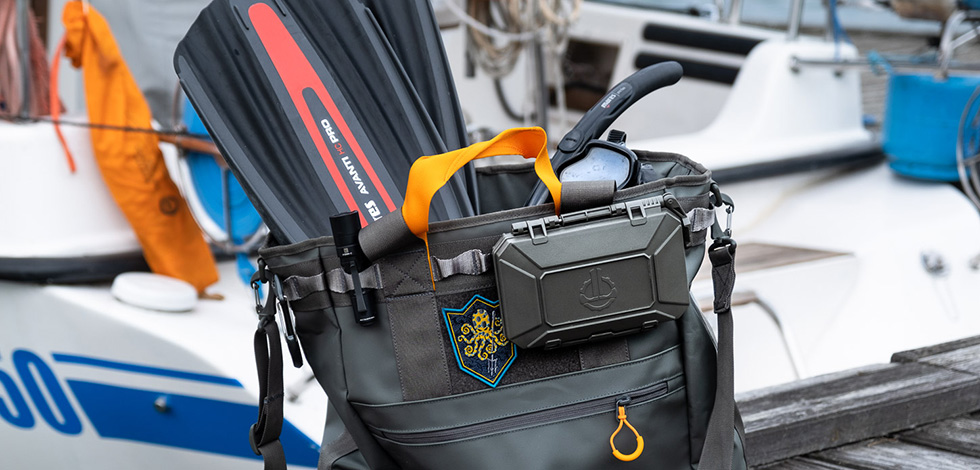My Favorite Gear for Aquatic Adventures
I’ve been sailing for 36 years now, both on lakes and open sea. So maybe it wouldn’t be a bad idea to share some thoughts about the gear I’ve been using during my aquatic adventures? Both classic carry items like bags and pouches, but also what I carry on me as my EDC when sailing and which tools I use on deck, in a galley, and when camping at the river bank. Most of these items would also work for overlanding, general camping, some even for hiking. But all of them I find especially suited during aquatic activities, like canoeing, kayaking, rafting, and foremost sailing (especially on lakes).
Best Gear Carry Bag: Prometheus Design Werx ZCaB-AW
MSRP: $119
Best Overall Carry Bag: Prometheus Design Werx Road Warrior 45
MSRP: $139
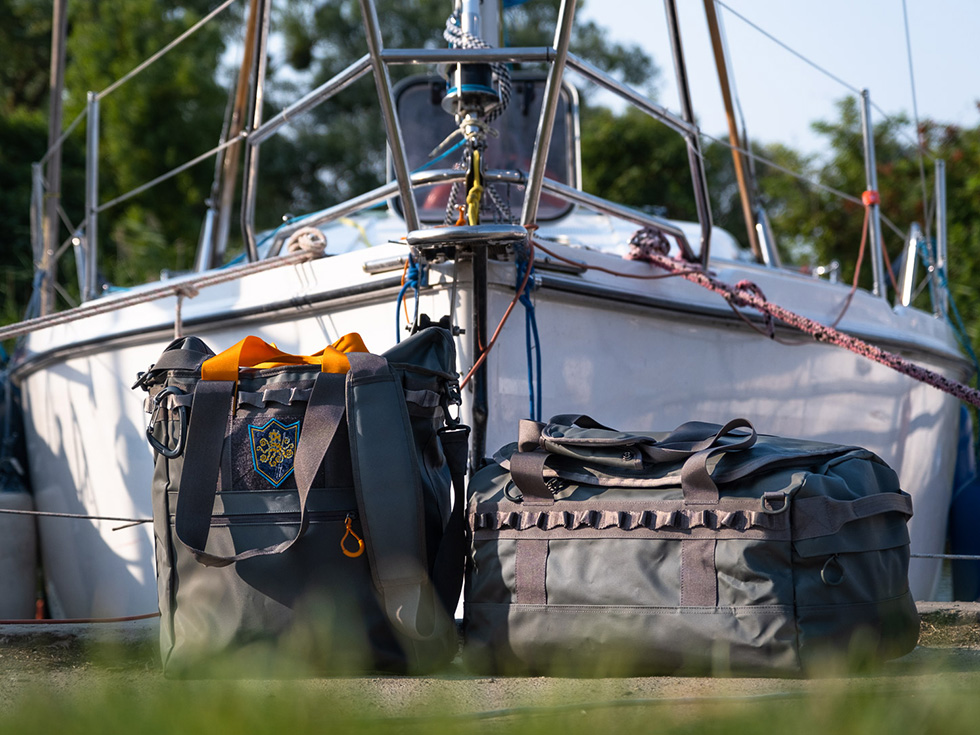
There’s one thing in a sailing yacht that is always in scarcity – personal space. My ideal general use bag is between 40 and 50 liters, tough, with just basic organization inside (as it always eats up space). It should be pretty much water-resistant on the sides and bottom – just enough to keep stuff dry but not fully sealed so that clothes won’t rot. Believe me, the LAST thing you want on a sailboat is a fully sealed bag. No matter how hard you try all your stuff will start stinking after 3-4 days max. Sailors’ bags were made of waxed canvas (with just a drawcord closure) for ages for a reason.
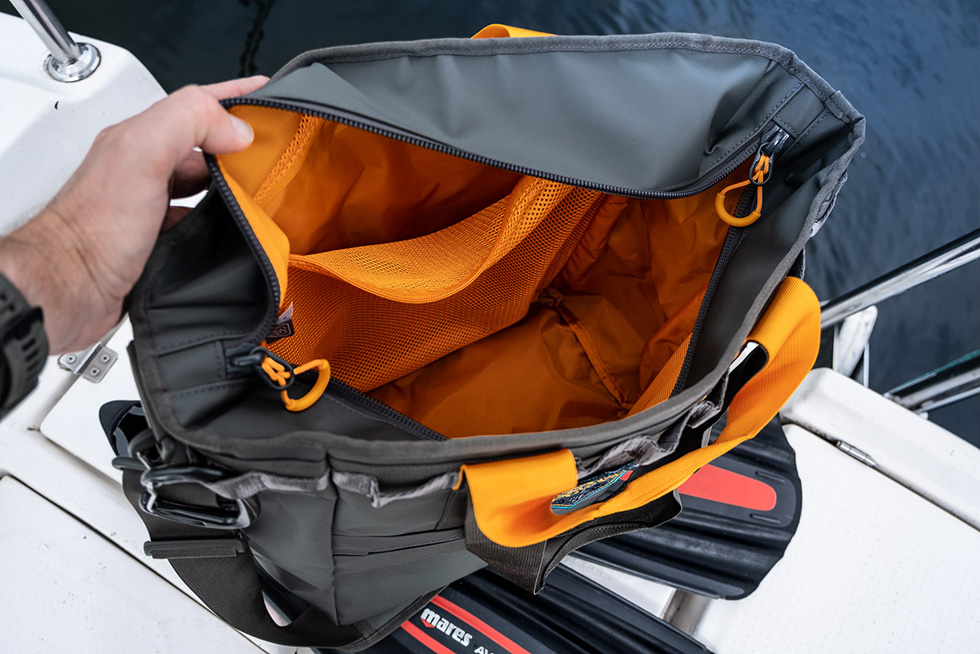
The Road Warrior duffel, made with strong 1000D PVC Tarpaulin waterproof material, fits the bill quite perfectly for me. During my cruise it kept my clothing dry, didn’t take up a lot of space, and was tough enough for a rough sailor’s life. On top of that, a vibrant orange interior helps to find stuff inside the bag. It’s not overly complicated inside but still provides enough organization. The handles are loose enough to carry some extra items on top of the bag (like snorkeling blades in my case). A really good one.
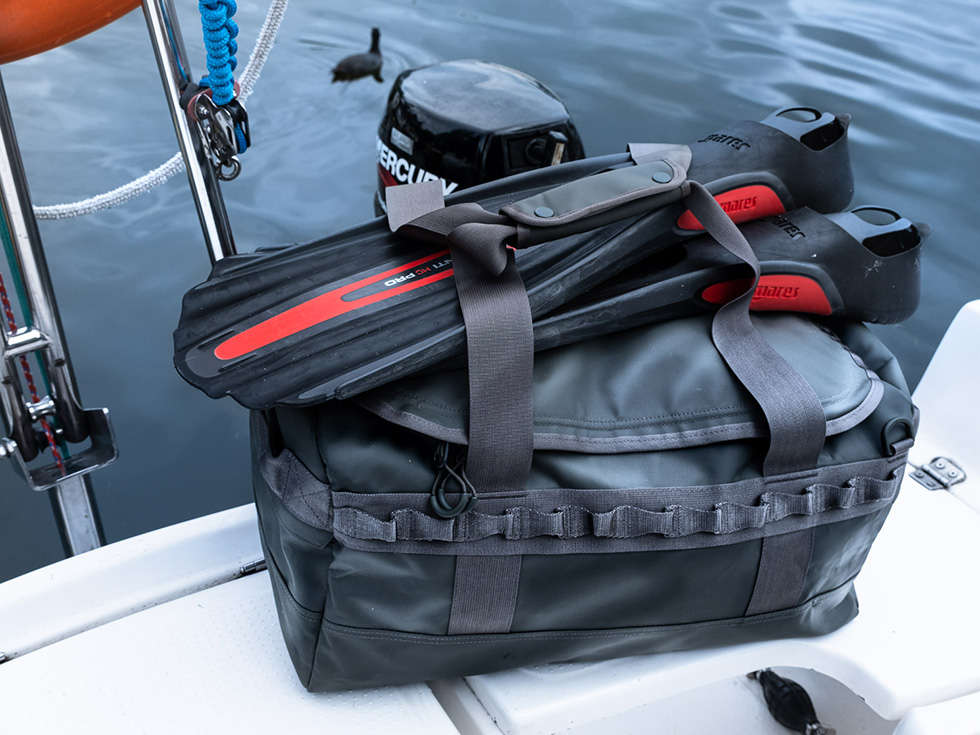
For all my technical gear and photography equipment I went with the PDW ZCaB-AW (Zipper Carry-All Bag – All Weather). It’s a big (1800 cubic inches) and modern tote-style bag, designed for all-weather carry. The outer material is exactly the same as on the duffel (so fully waterproof) and contents are additionally protected with a tough central top zipper. Sure, it’s not a submersible bag, but should easily survive some rain or wet conditions. The webbing daisy-chain outside works fine for additional pouch attachment, carabiners, even my SureFire Backup flashlight fits there (like it’d been tailor-made). The ZCaB-AW also makes an awesome beach bag to carry a water bottle, IFAK, towel, snorkeling kit, etc. plus Thyrm watertight container attached via a MOLLE system on the outside with some critical items inside (wallet, mobile phone, etc.). It really proved to be a perfect aquatic gear carry companion.

Best Small Gear Carry Pouch: Dan Matsuda – EDC Pouch
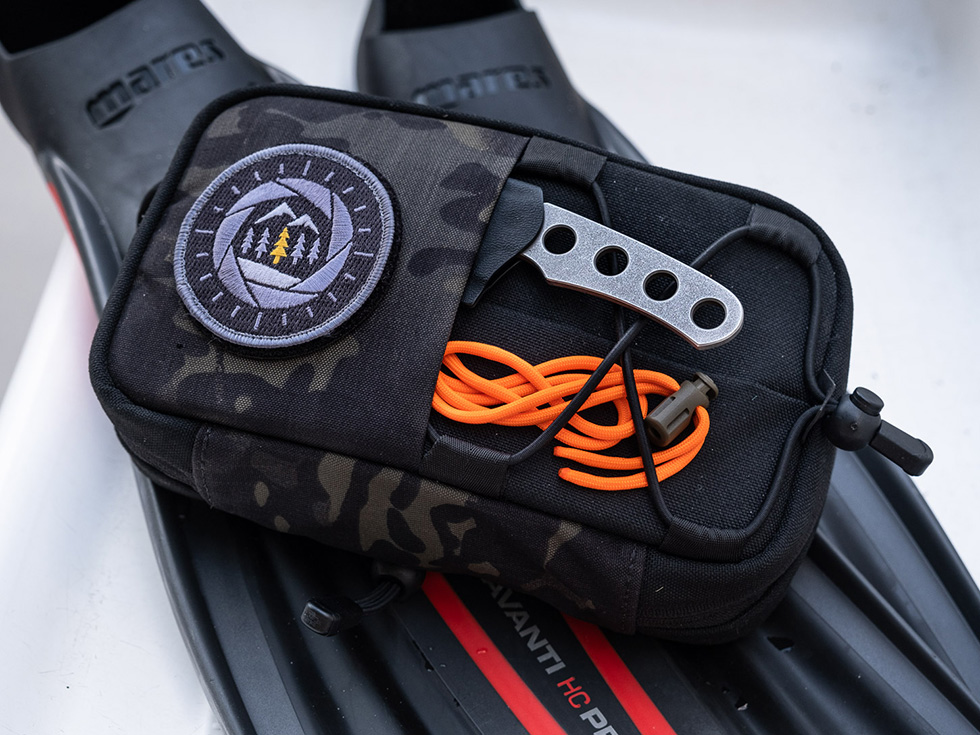
As I mentioned before, a sailing boat is not the most spacious place you can imagine, so keeping personal items organized is a must. I’ve tried various EDC pouches in the last years, by many manufacturers and custom makers as well. And yet… that Matsuda pouch is for now my favorite one. It has a modular interior with Velcro panels and corresponding rubber organizers, a central safe compartment, an outside pocket, Velcro, and bungee. And it’s spacious and extremely efficient for organization considering the size.
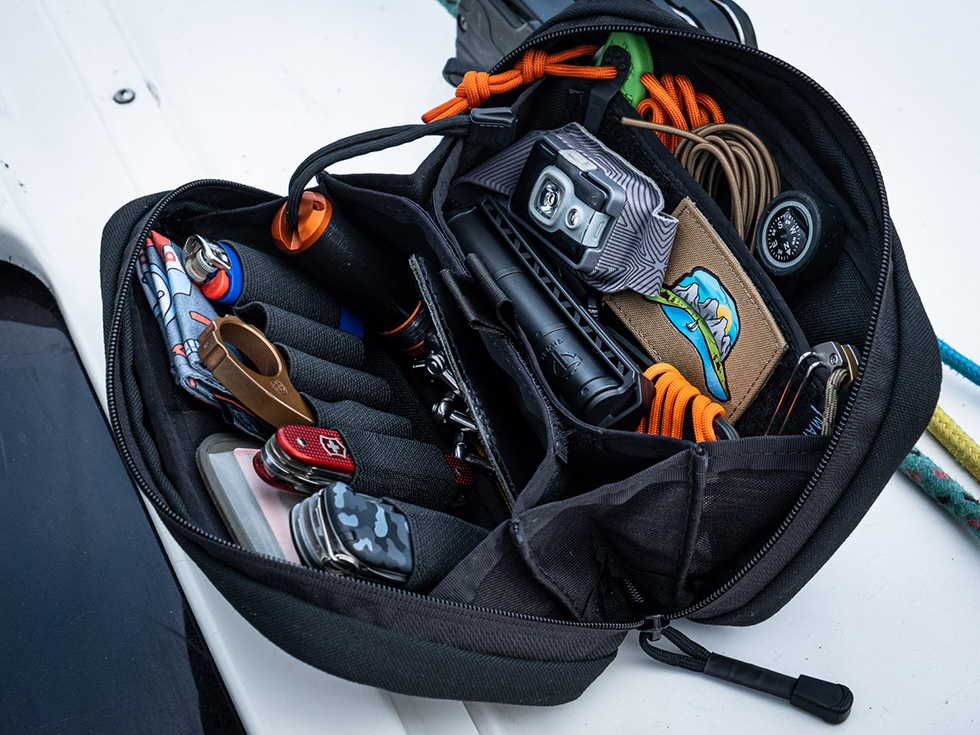
As you can see I was able to load in almost all my small gear and still there was some space left. It’s a custom-made item, sewn with extreme attention to detail. Actually, I’ve never had such a perfectly made pouch, pack, or bag. Made of 1000D Cordura it should serve me well for many years, but Dan also makes it with X-Pac and other materials if 1000D is too heavy for you. The only downside is the quite hefty price and demand exceeding supply… it took me about a year to hunt one down. Still, it was more than worth the effort.
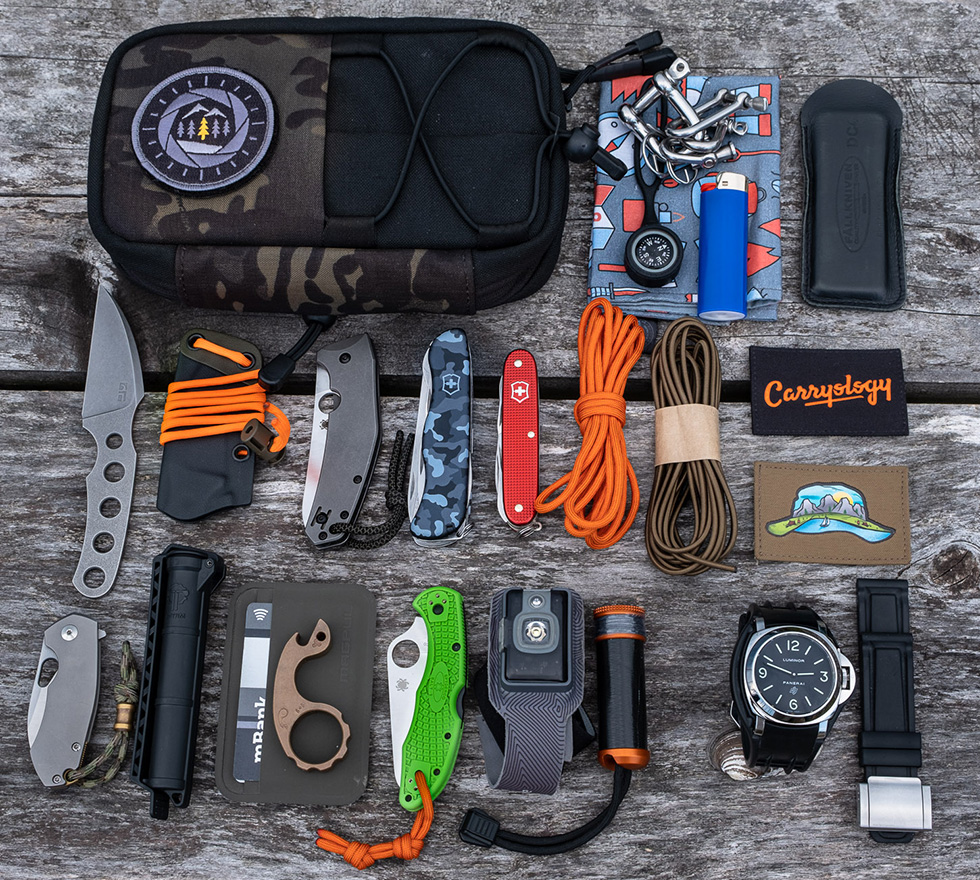
Best Compact Tool Pouch: Wotancraft Hangable Toiletry Bag
This is a funny one… yes, the title is correct! It’s intended to be a toiletry bag but to me, it proved to be a perfect tool pouch foremost. Three big vertical sleeves are great for paracord, a sharpener, multitools, etc. Just below that there’s a big full-zip compartment for all the loose items like cord, tape, some glue containers, screwdriver bits, mini butane torch, etc. And on top of this – a small mesh pouch for tiny items like a Swiss Army Knife, BIC lighter, etc.
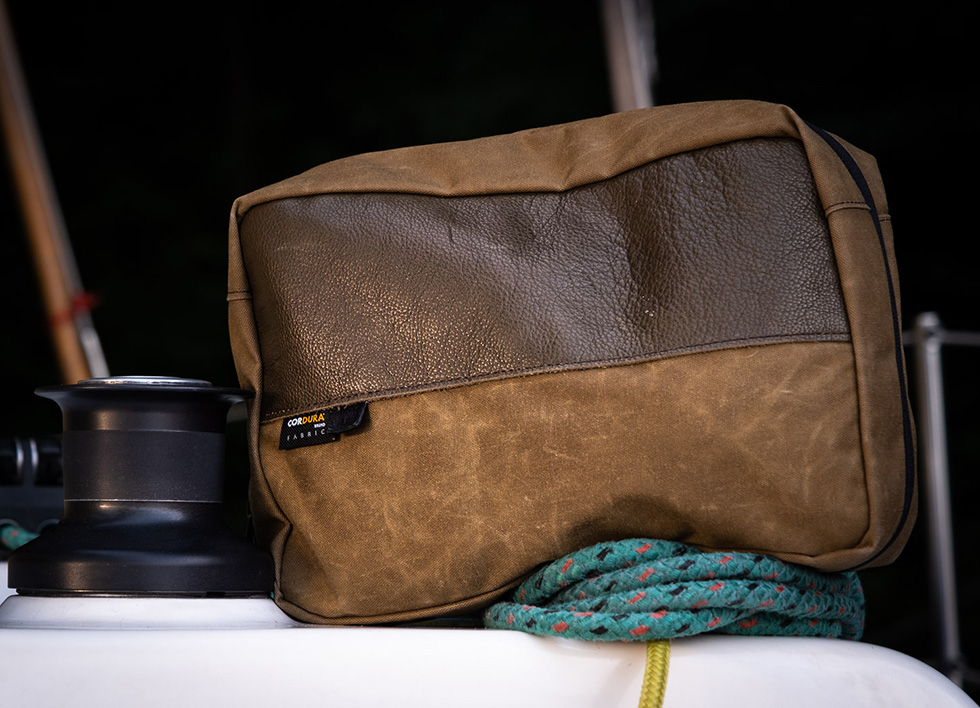
But the coolest part is the ability to hang it on any yacht part like a capstan, railing, etc. On a yacht that’s usually THE ONLY way to fix a tool pouch when working outside. There’s no space for a classic toolbox on a wobbling deck – but a hangable design solves the problem. It’s also made of tough Cordura, so you can load it with heavy tools and gear without worrying too much. Of course, you can use it as a Dopp kit too… but hey, mine fits easily in a 3 times smaller pouch. Space is scarce, remember?
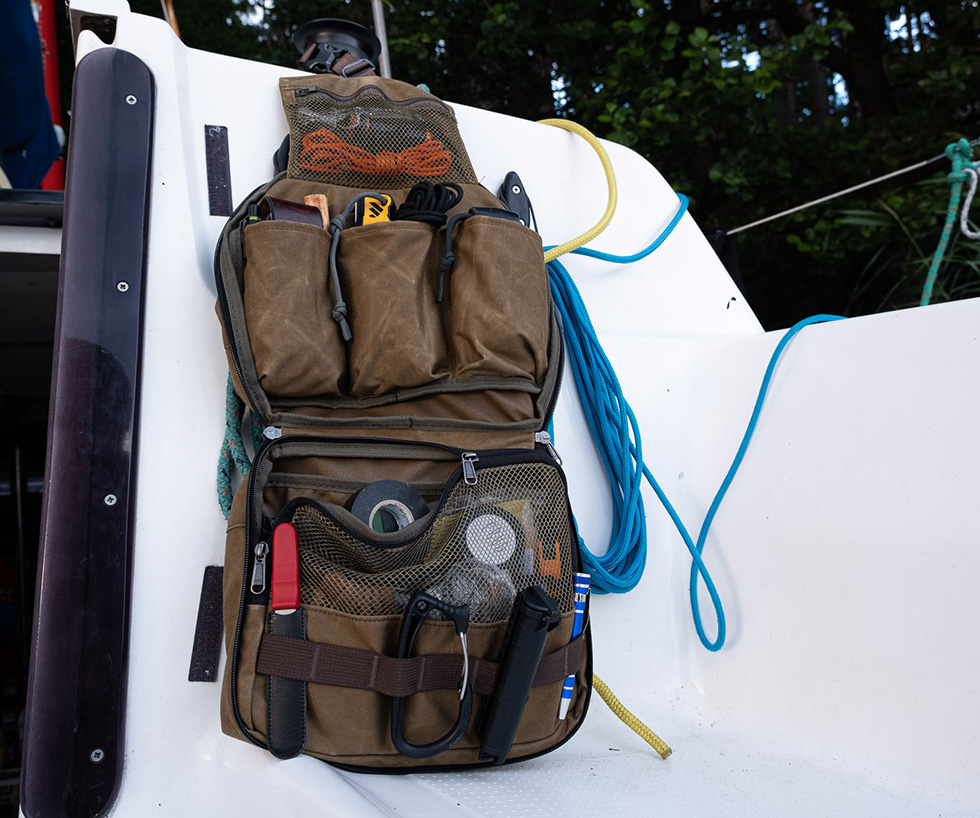
Best Medical Gear Carry: ITS Tactical ETA Trauma Kit Pouch (Tallboy) and Slimline Pouch (IFAK)
Practically, in most scenarios a good IFAK (Individual First Aid Kit) is all you need for a vacation. However, that’s not the case when you’re sailing on a sea or even big wild lakes and the nearest emergency room is hours (if not days) away. Bleeding control is a major concern when you’re in a remote location, and you can’t be more remote than in the middle of a sea.
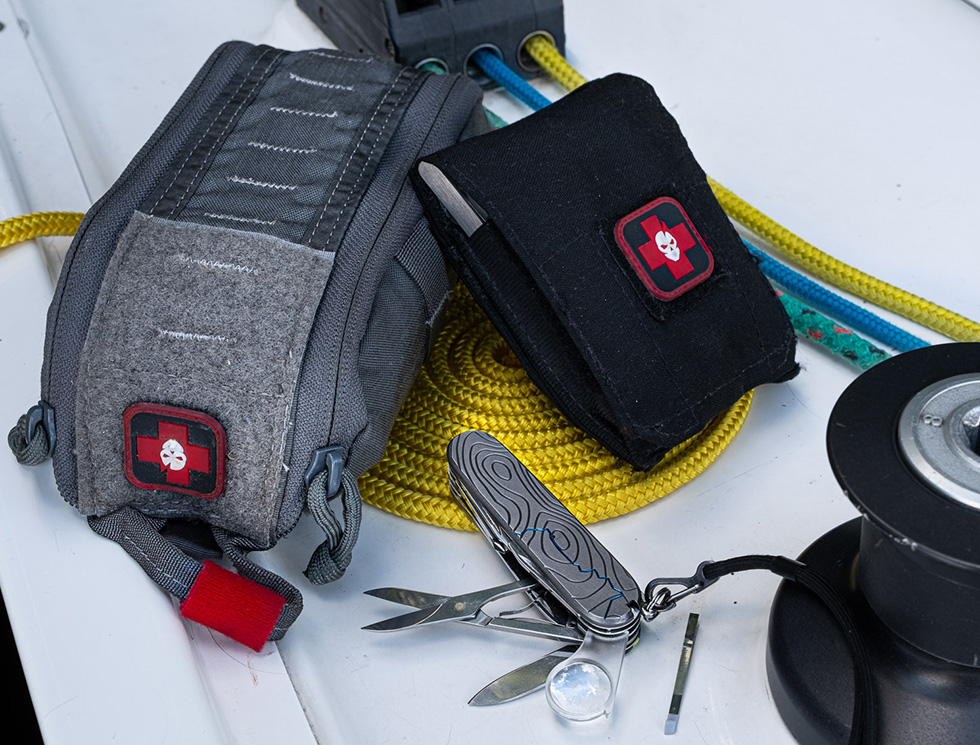
So yeah, a serious trauma kit is a MUST, there’s no excuse for not having one. It must contain at least trauma shears, a tourniquet, certified pressure dressing, and some sort of bleeding control hemostatic gauze for wound packing like Celox or QuikClot. There are many companies offering quality trauma kits, but my personal choice for many years has been the ITS Tactical Trauma Kit in a Tallboy pouch and a Slimline Pouch for IFAK. These guys really know what they’re doing when designing medkits.
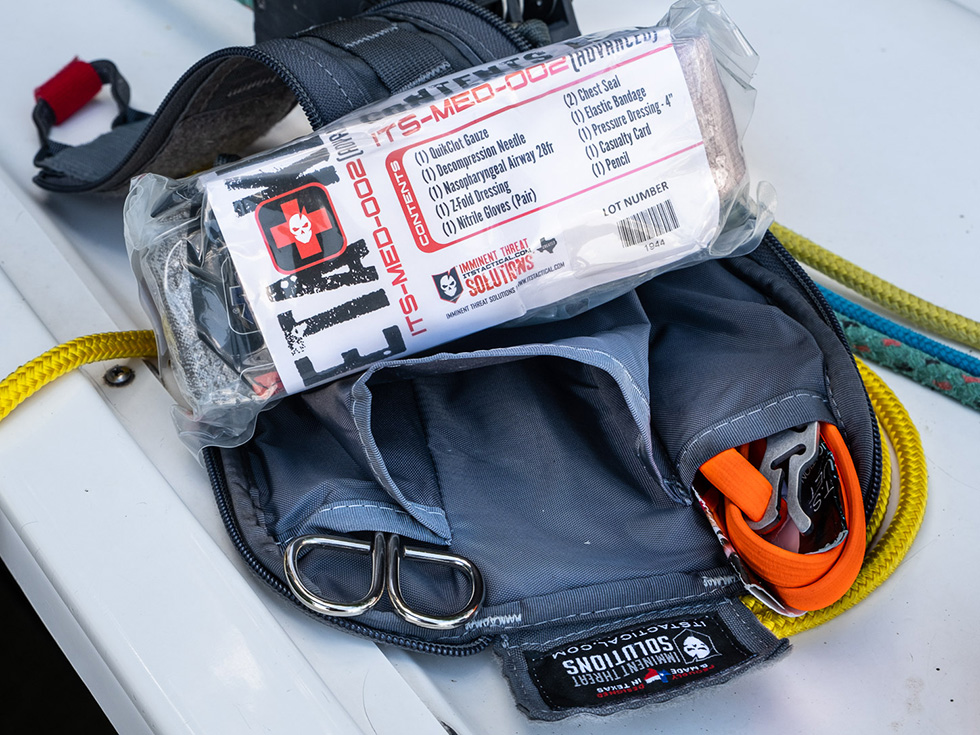
And for IFAK I keep it really simple, it’s more like a boo-boo kit actually and contains small wound control stuff (bandaids, steri-strips), antibiotic gel, antiseptic spray, some small gauze, tweezers, pain killers, and anti-allergy pills. Plus a small Victorinox Classic SD on a mini-carabiner, which contains tweezers, scissors, and a nail file. The rest is less important (but still handy). If possible I take with me a Victorinox Explorer as well, which contains bigger scissors, tweezers, and a magnifying glass… and why? Well, if you’ve ever experienced a fiberglass splinter in your finger then you know why (modern yachts are made of fiberglass, so the chance is fair).
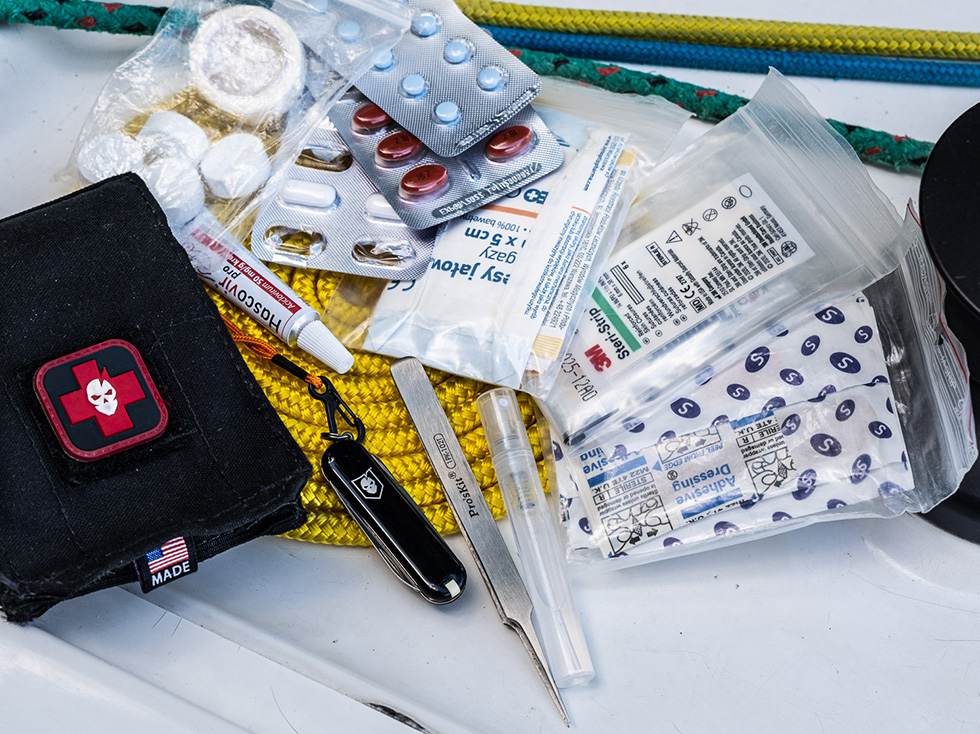
Best Tough Carry Container: Thyrm DarkVault
MSRP: $59.99 – $89.99
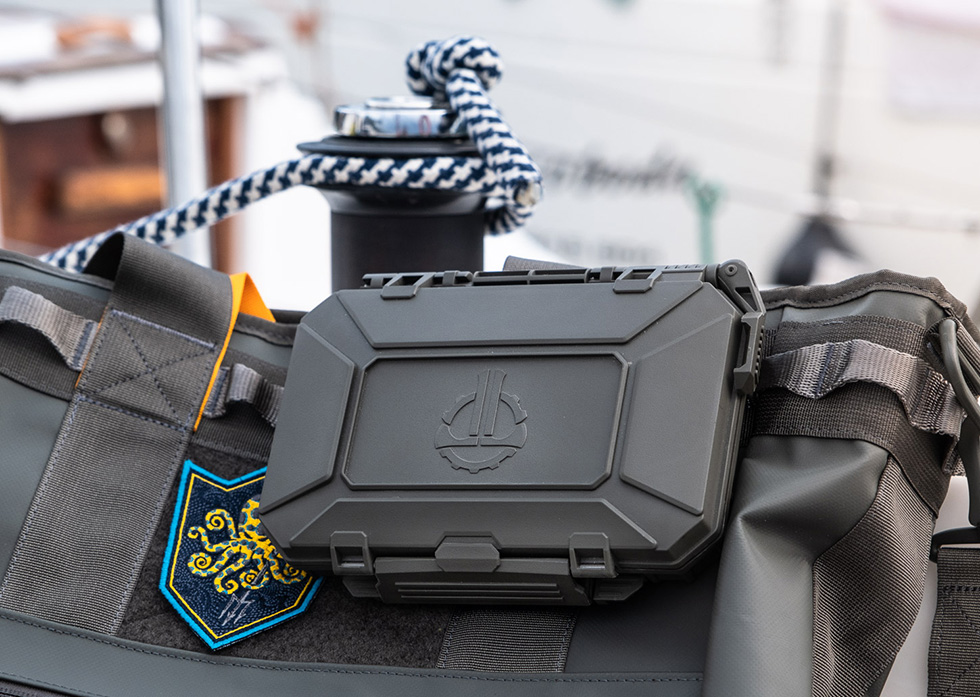
Critical stuff needs critical protection. Thyrm’s vault couldn’t be named better – it’s made of supertough polymer, which can easily survive a drop on a concrete floor or being run over with a SUV. Of course, it’s also fully watertight (sealed with a rubber gasket) and can even be locked or protected with a security seal if needed.
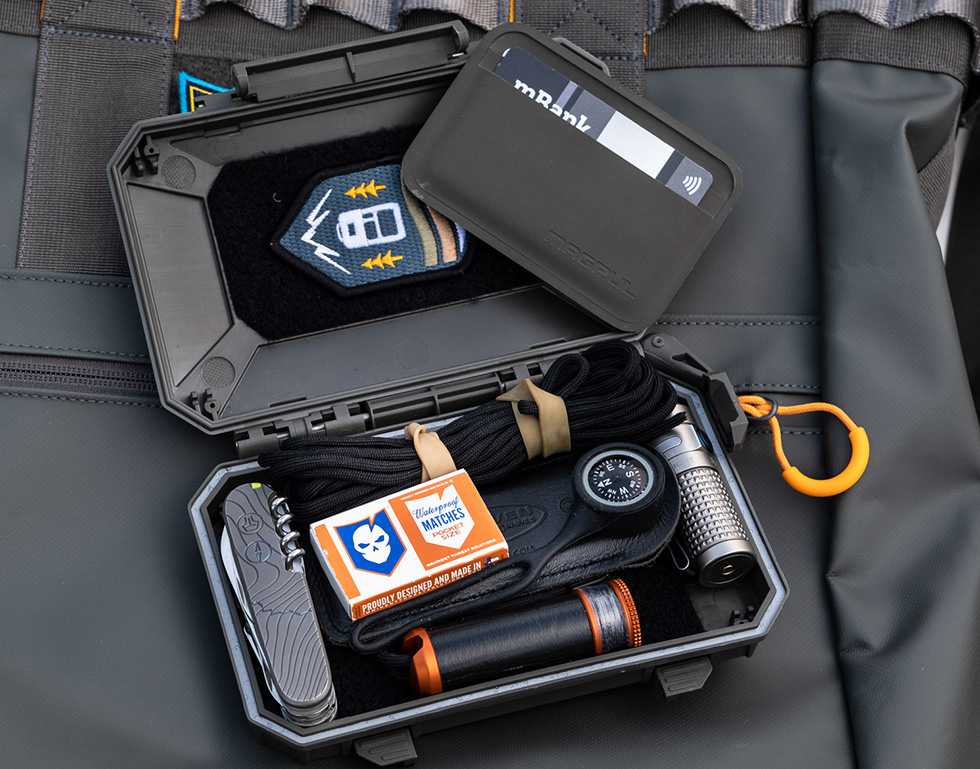
I usually put my DarkVault on a pack or bag (it fits the PDW ZCaB-AW perfectly) and store my most important items inside. Pocket knife, wallet, flashlight, etc. It can be opened to 90 degrees or fully flat, and the opening action is adjustable via a small turning arm. It fits on MOLLE-compliant packs and vests too, but is also flat enough to just fit inside a pack or luggage. Velcro inside helps to organize the space a bit as well.
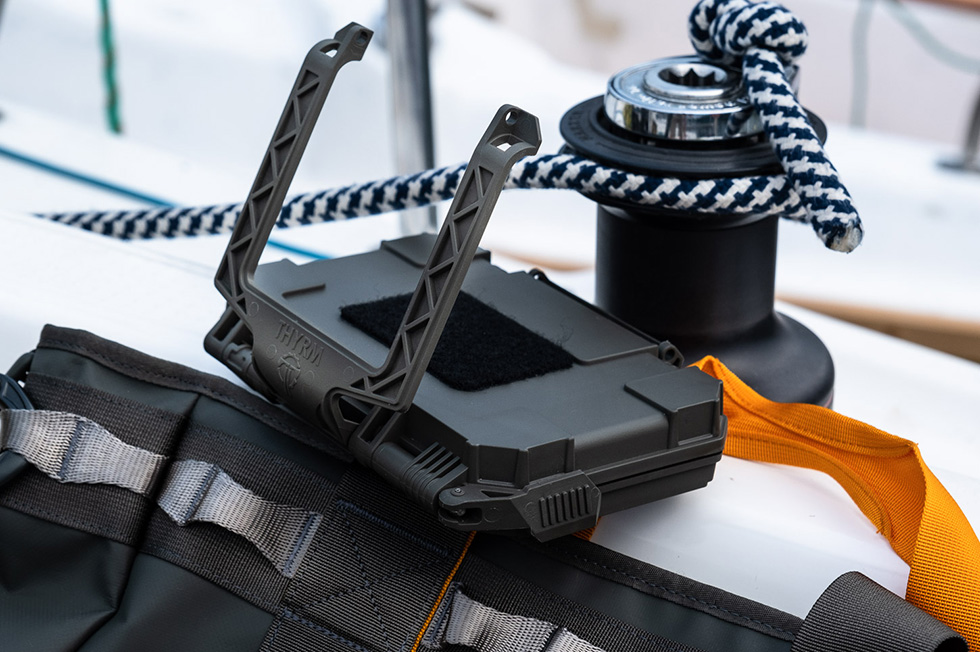
Best Waterproof Pouches: Nite Ize RunOff Series
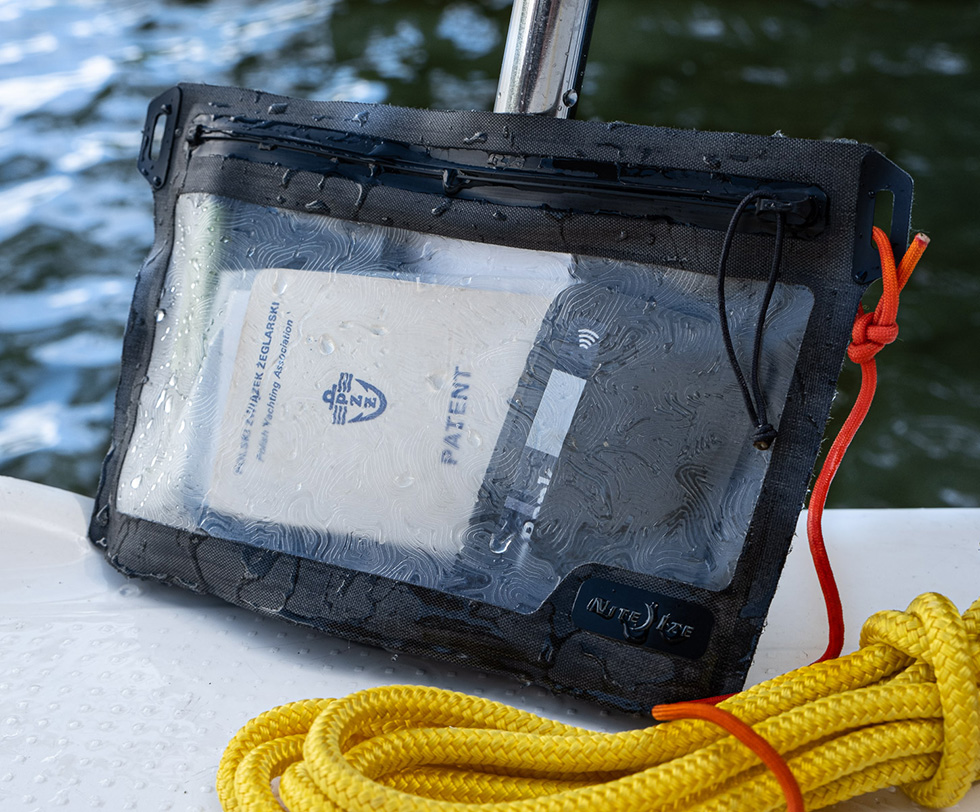
There are multiple companies offering protective pouches, but not a lot make them truly watertight and even submersible. Nite Ize does. The RunOff series uses a specially developed fully self-sealing zipper, which won’t let water in – no matter what happens. Flat RunOff pockets are great for paper documents, money bills, cards, and any other flat items. There are also bigger pouches in the range, which I use as tech pouches for cables, chargers, SSD drives, etc. There’s even one in the size of a small packing cube, designed for bigger items, which I use for my SSD backup drive and other bulky gear.
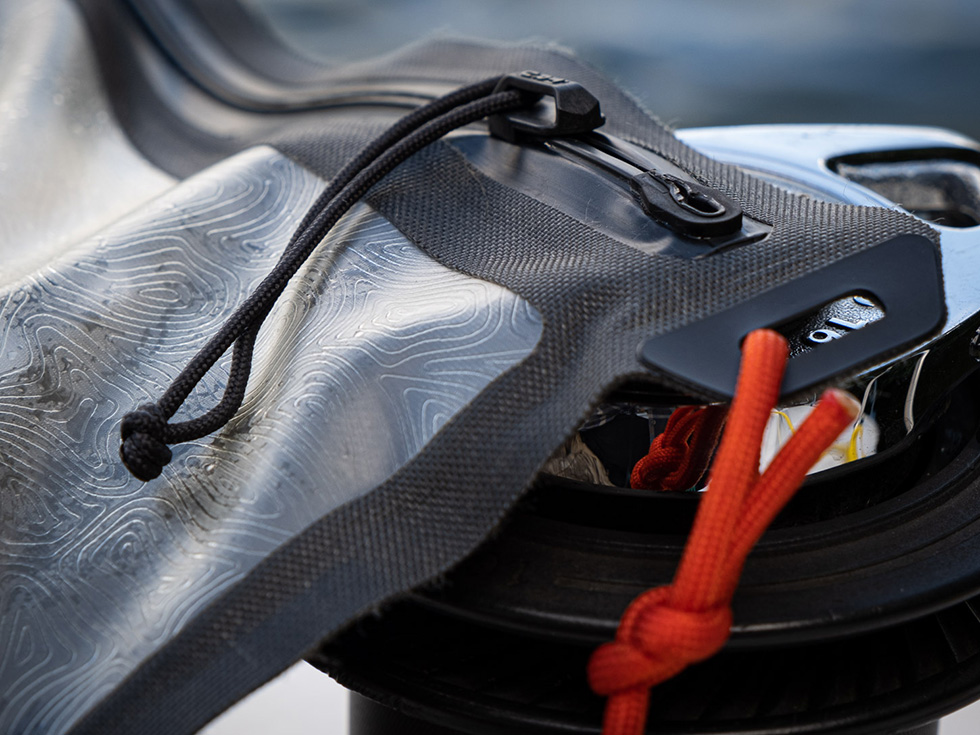
Most models of RunOff pouches are backed with loops, which can be used to attach the pouches to a backpack (or even belt). And all of them feature corner lanyard holes if an additional safety cord is required – on a yacht or kayak it usually is. Finally, they also designed a neat smartphone holder, perfect for rafting, paddle-boarding, or kayaking. These pouches even allow for touch-control and are clear enough to take really crisp photos through them.
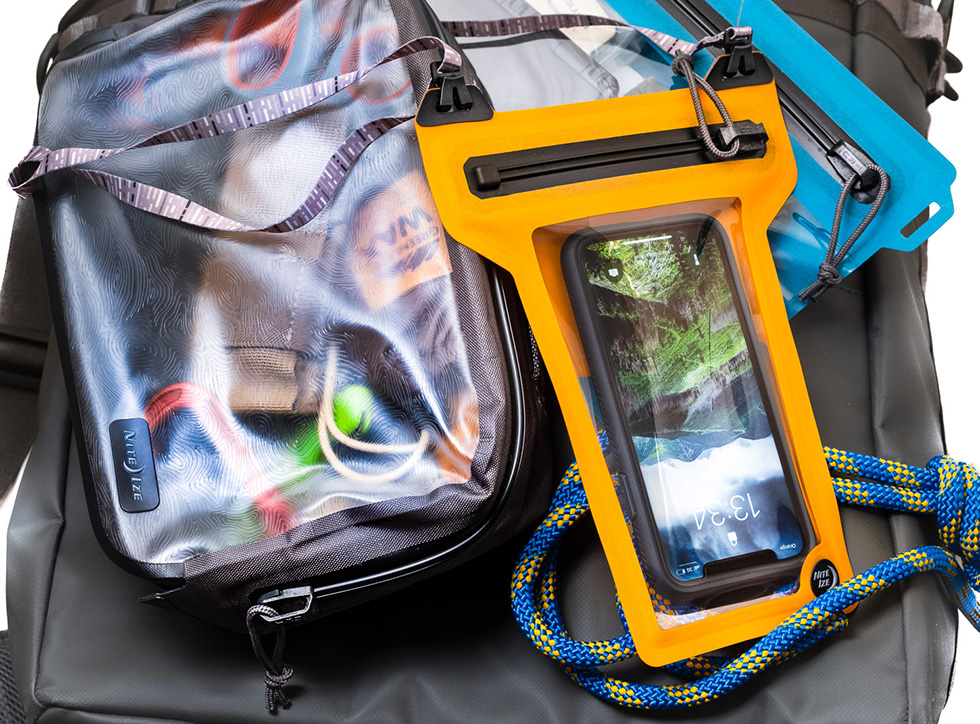
Best Aquatic Adventure Top: Prometheus Design Werx Helios Shirt
MSRP: $45
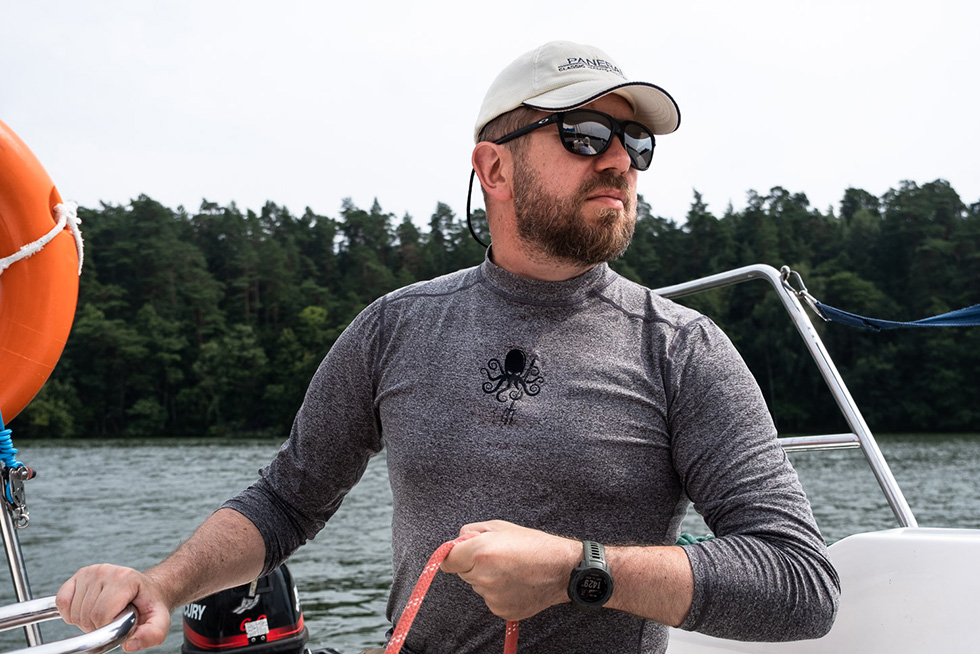
Sailing, canoeing, or kayaking during summer are all about wind, sun, and water spray. The PDW Helios Shirt addresses all of these in a really cool design and dedicated material choice. It’s made of a polyester blend containing about 6% spandex for wearing comfort. It’s semi-relaxed, breathes perfectly, protects from sun (30 UPF factor), and dries extremely fast. It has anti-microbial properties too, so stays fresh relatively long, which is great news if you live for a week or two on a sailing yacht. It’s super-light at just 125 grams and it’s made in the US in sunny California.
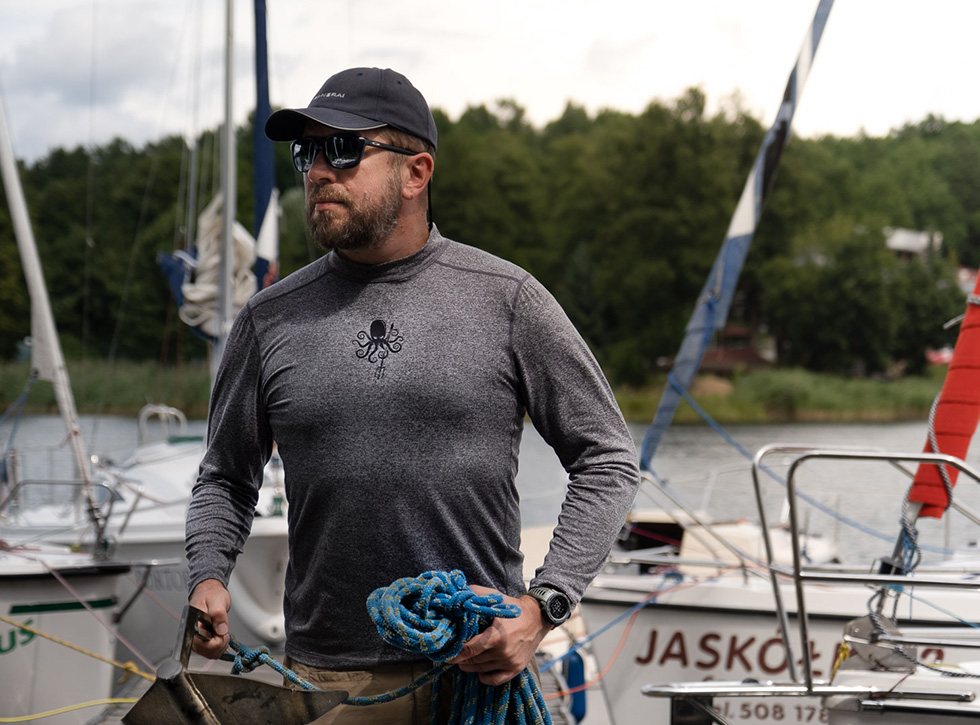
What I like about the Helios shirt is the super-soft next-to-skin feel of the stretchy material with flat-lock seam construction. Honestly, I was actually surprised by how good it feels. It kept me warm and also somewhat protected from breeze and water spray. And it dries really fast. PDW is known for amazing graphic designs, and that black Kraken with a trident printed on the chest is no exception. At just $45 it is not prohibitively expensive so if you’re into sailing, kayaking, paddle-boarding, rafting, etc. it should be a no-brainer for you. It’s available as a hoodie as well.
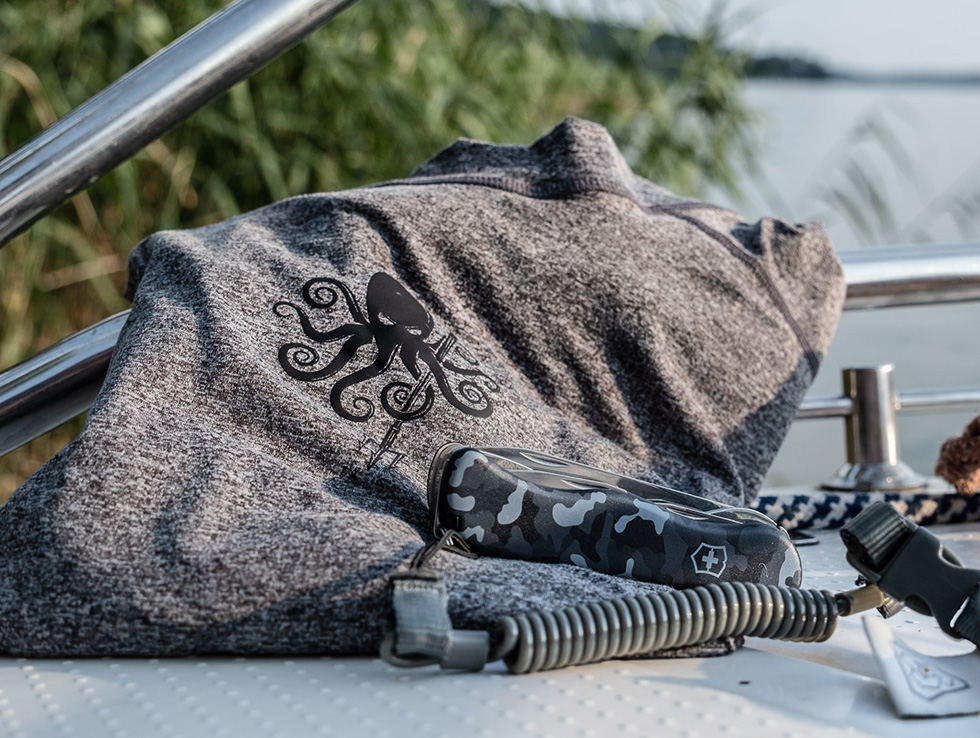
Best Headwear: Real Deal Brazil Tarp Hat
$39.99
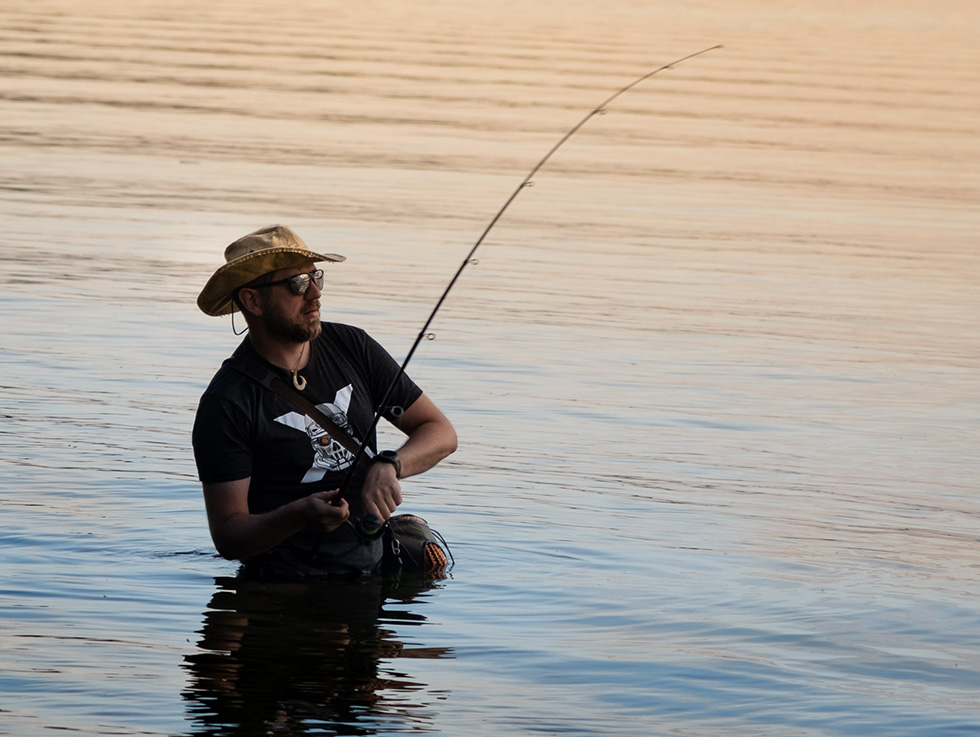
Made of recycled cotton canvas tarps, previously used on all kinds of trucks in a Brazilian jungle, these hats are both lightweight and tough. They look raw, well-aged, and kind of adventurous. I absolutely love the quote on the inside (see the pic) and I can confirm it’s 100% correct. I’ve been using one for many years now, much more than a decade. It’s an accessory that is a must for me when leaving for vacations, especially if spending time around a river or lake.
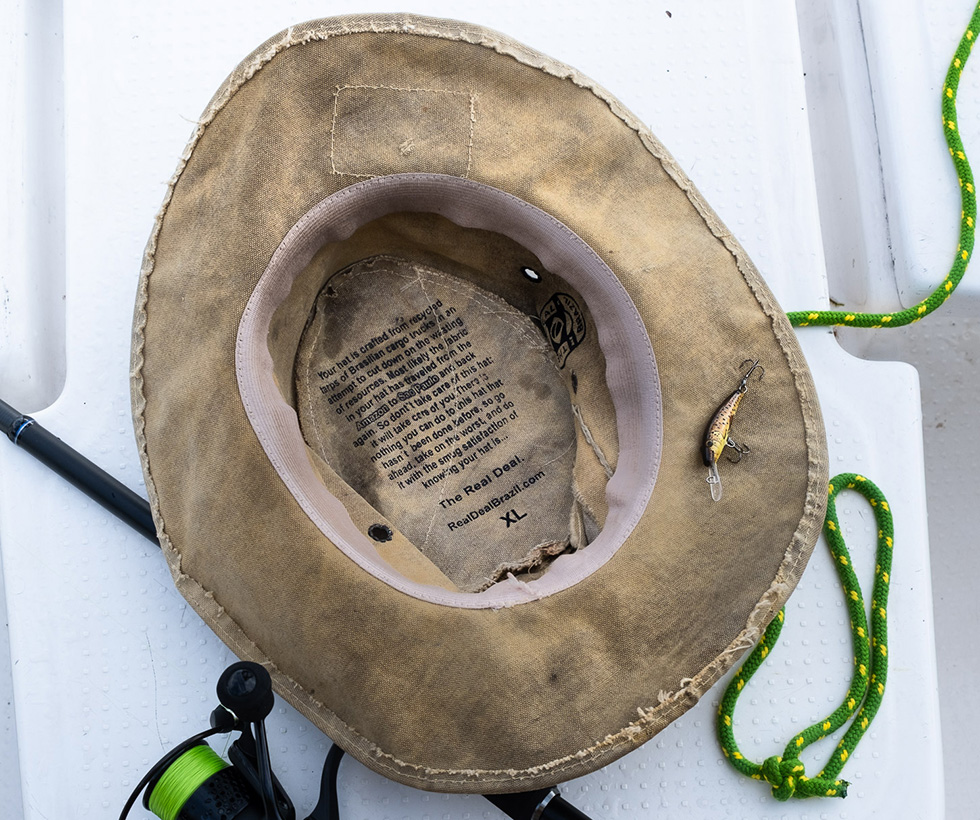
With that broad brim and super-light construction, it’s simply made for sunny days. It protects from direct sun not just your eyes and face (like a baseball cap does) but also keeps your ears and neck in shade. It’s my mandatory fishing accessory too. And it even protects from light summer rain almost as well as an umbrella. It was wet countless times, squashed, squeezed, stepped on, etc. and it keeps looking better and better. So yeah, it’s a highly recommended piece. And it simply looks so cool that even Indiana Jones would wear one… but I’ve heard there was no internet in the ’30s so he couldn’t order one. 😉
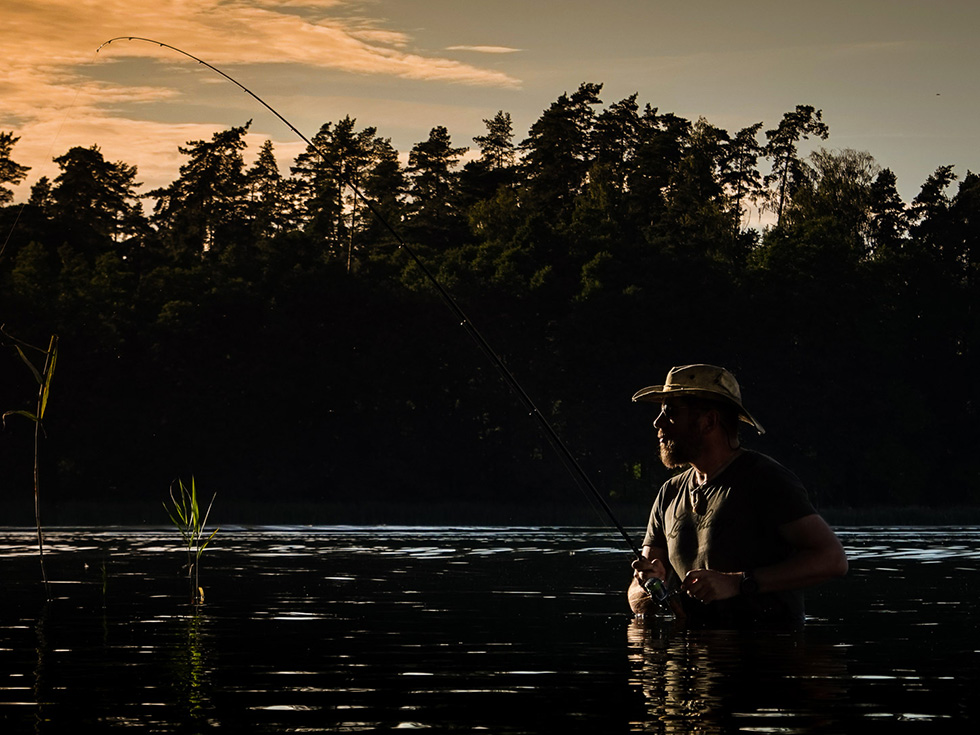
Best for Use on the Deck: Spyderco SALT series
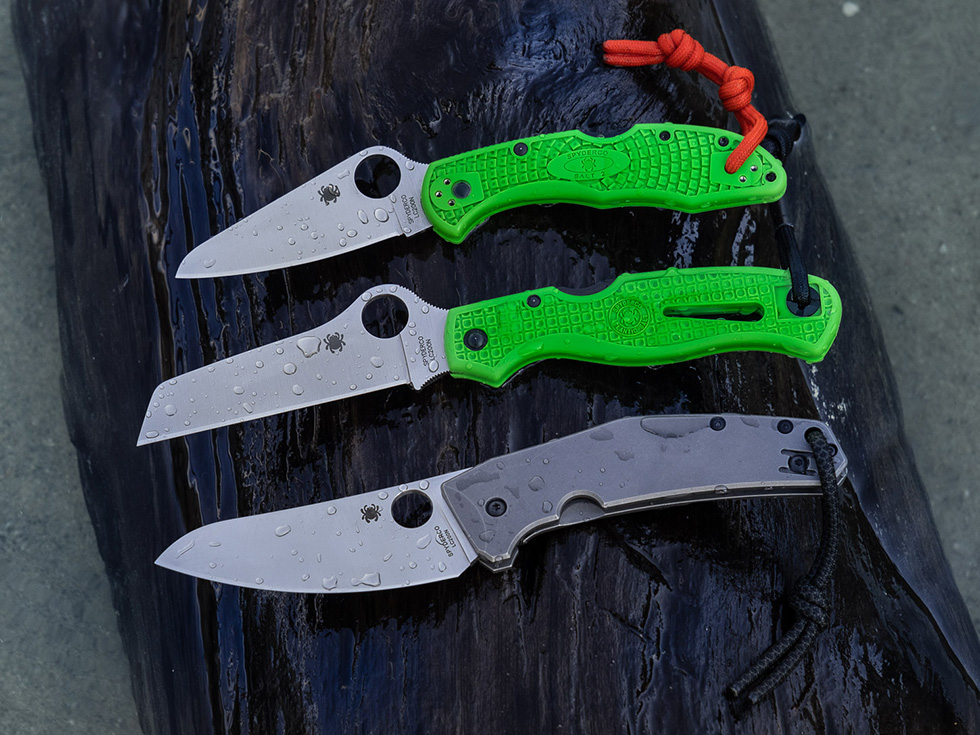
Spyderco’s SALT series has earned a stellar reputation among sailors, fishermen, and rafters. To make them even better Spyderco upgraded the series and changed H1 classic rustproof steel to LC200N steel on key models. LC200N is not only extremely resistant to corrosion but also holds the edge considerably better than the predecessor. It’s a very welcome upgrade and truly brings SALT knives to another level. So let me show you two examples, both featuring the new super-steel, which I’ve found extremely useful on the deck.
#1 – Atlantic Salt
A classic sailor’s knife with a straight edge and so-called sheepsfoot blade. Just keep an Atlantic Salt in a pocket – your daily life on the deck is really so much easier. And since it’s a linerless knife it is ultralight too. A clip and big lanyard hole make daily carry safe and easy. I modified mine slightly in the tip area, which now gives it a bit more of a dynamic look – but it’s still the same knife with the same set of sailor-oriented features:
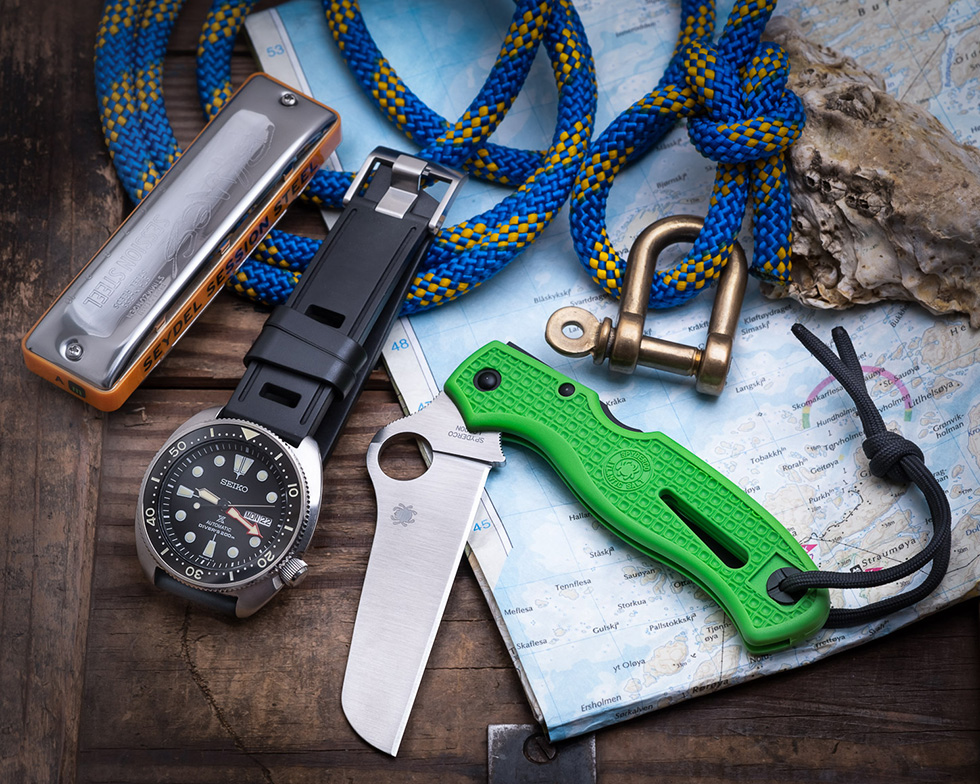
1. Straight edge and blunt tip – Have you ever had to cut a rope in a hurry? Under stress? On a waving deck? It’s neither fun nor easy, believe me. Such a semi-blunt tip is key for your own safety. And a straight edge prevents the rope from slipping off it. Claw-shaped blades are fine too, but they just don’t work well on sails and rope repairs, when you need to lick a boat’s wounds after a heavy storm. A straight edge works best for the majority of boat-specific jobs. I’ve been sailing for more than 35 years now, been there, done that. Straight edge wins.
2. Shackle key built into the handle. I know the FRN handle is just a kind of reinforced nylon material, but it’s still much harder than your fingertips. Unscrewing a shackle can be a real pain in the neck, so this little feature within hand’s reach is extremely useful. It’s just there when you need it.
3. That enhanced hump is a feature too! First of all the oversized opening hole makes blade deployment faster and easier. But it can also work as a wrench on big slots like in a standard yacht’s water intake plug. This slot is too big for a standard screwdriver, and a dedicated key is usually gone after two days of sailing. The Atlantic Salt solves this perfectly.
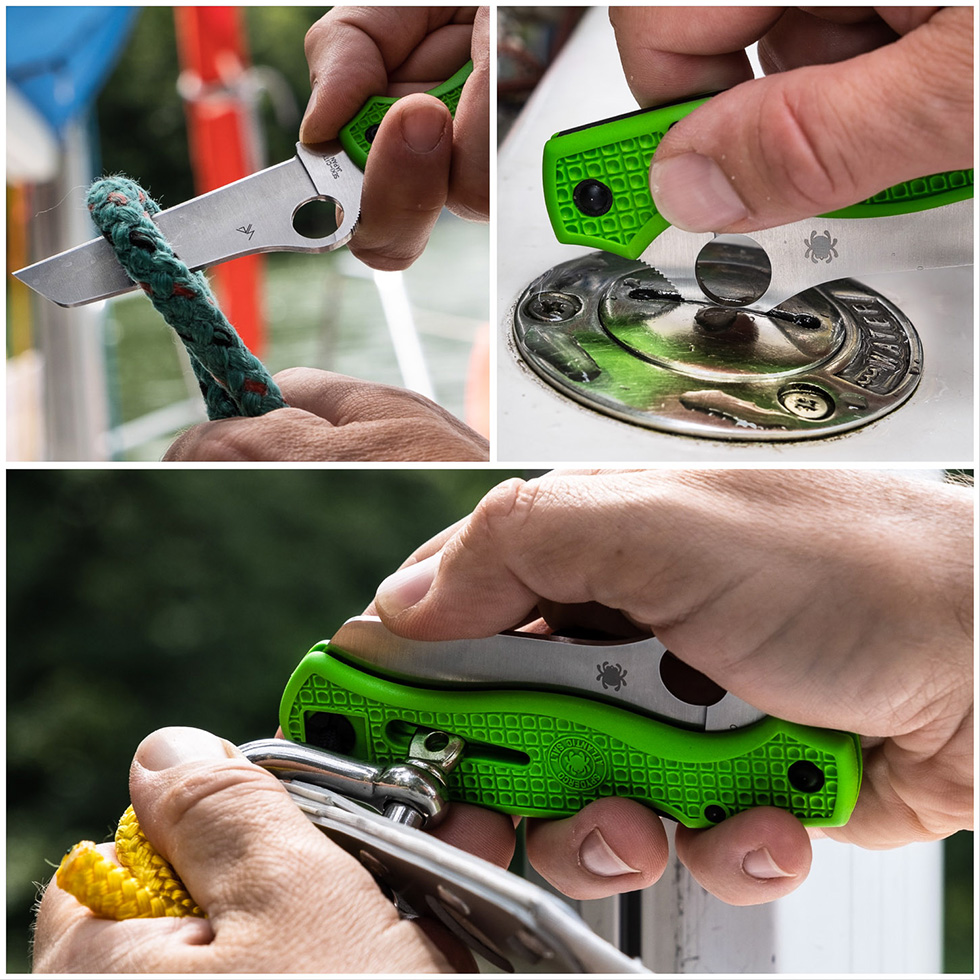
Another SALT family member, which is super handy at any vacation trip – a dedicated kitchen pocketknife. And it really works great for food preparation. I’ve been using mine for three summer seasons now and love it. The blade is thin and tall, with a full-flat grind and a nice belly. The raised handle helps a lot for using it on a cutting board. Thanks to all these features it cuts through food like a lightsaber! A true chef’s knife in your pocket. Possibly my most used folder ever.
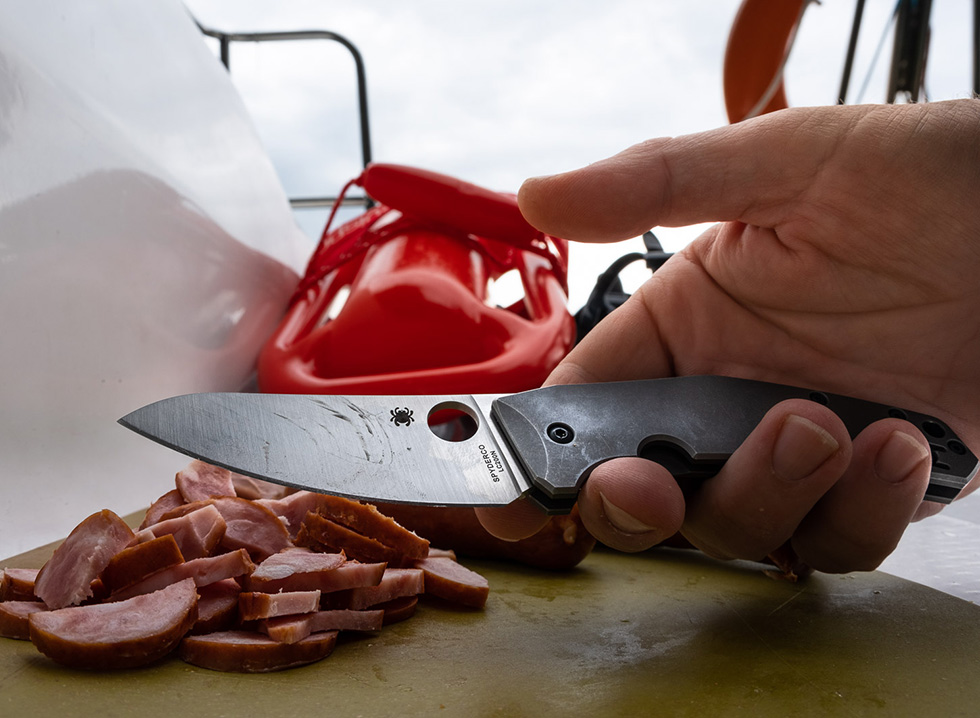
The LC200N blade and titanium handle make it easy to clean, fully rustproof, and ensures anti-microbial properties. Of course, it’s great not just for boating, but also for hiking, overlanding, and any camp kitchen use you can imagine. Thin and lightweight, with a deep-carry clip, it simply disappears in a pocket. It’s designed by Marcin Slysz (IG: marcins_knives), who is one of the most sought-after custom knifemakers today.
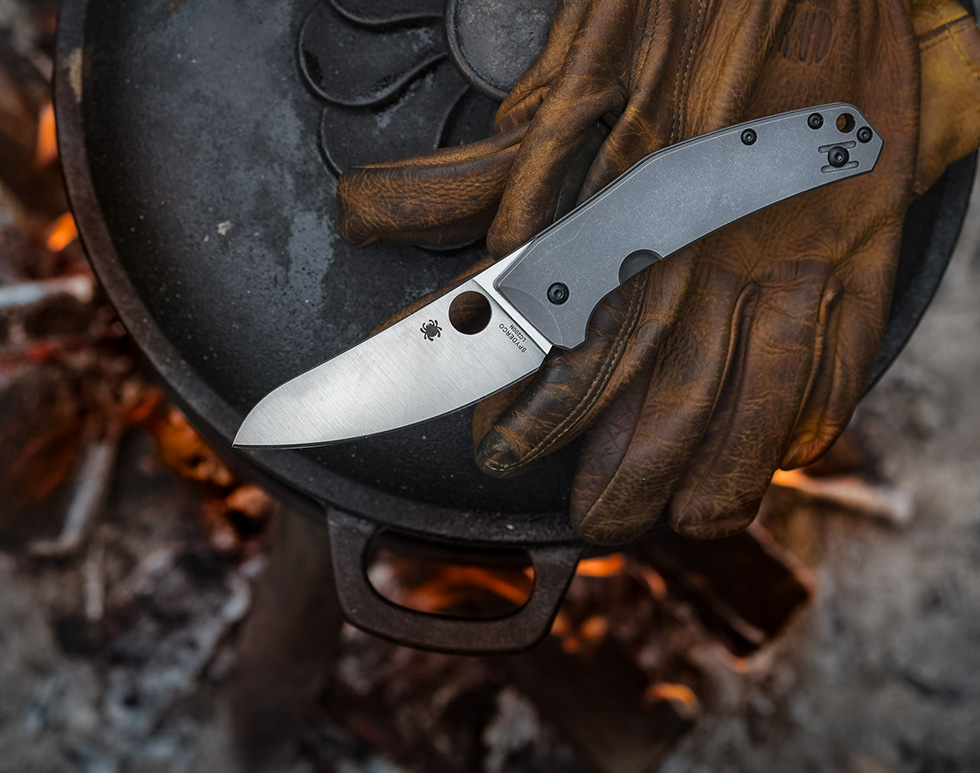
Best for Worst Wet Conditions: Terrain 365 STS-AT
MSRP: $395
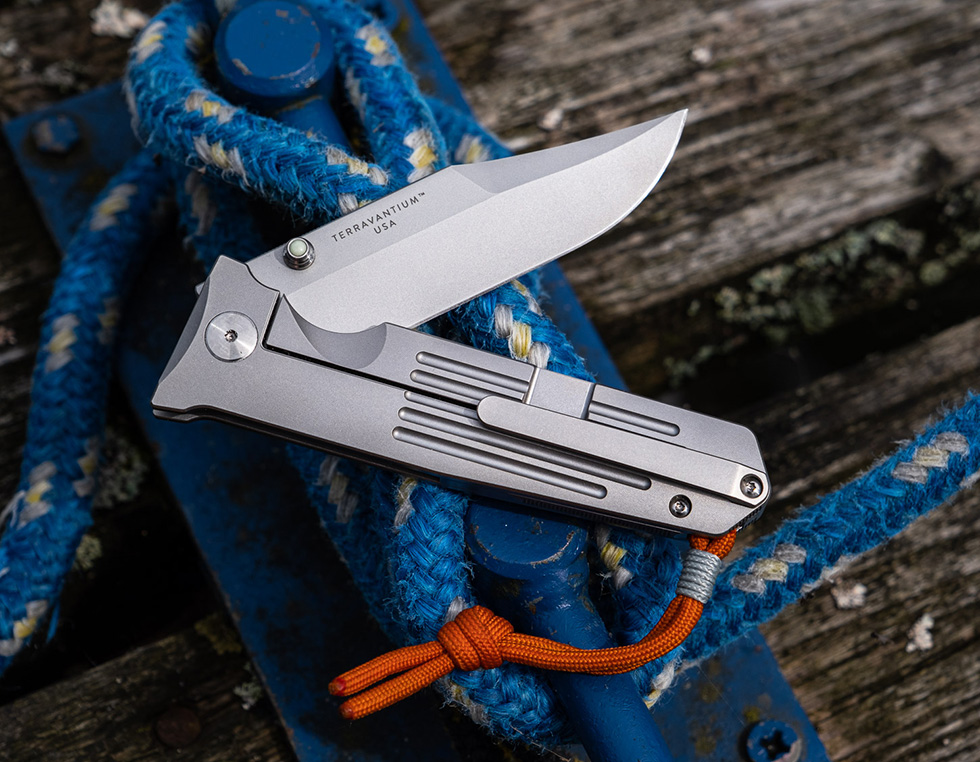
There’s only ONE way to make a knife totally stainless under any conditions, including hot and humid saltwater areas – simply don’t use steel, at all! Terrain 365 did just that and replaced the stainless steel blade with Terravantium alloy, which is the newest (and the best these days) cobalt-based alloy. It’s rustproof, it’s sharp and it keeps an aggressive edge for a long, long time thanks to self-sharpening proprieties. Terravantium exposes super-hard and sharp nano-sized vanadium carbides from the cobalt carrier structure during hard use. Sounds like magic, right? But it’s actually science, a high-end metallurgy exactly. And it really works!
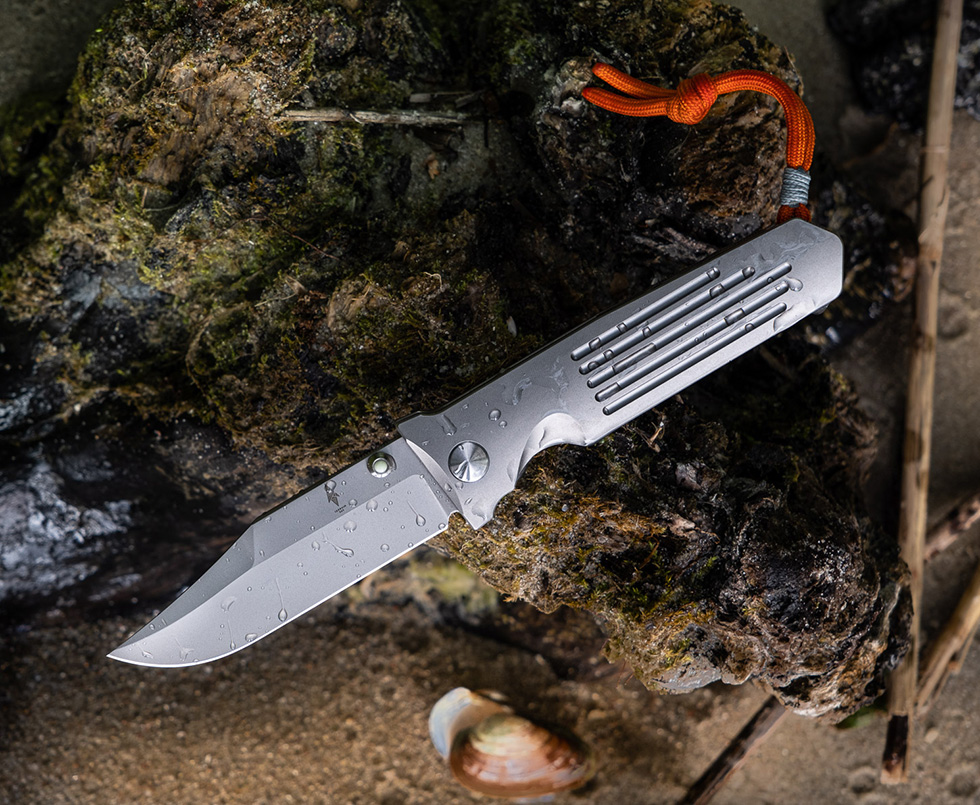
So if you’re looking for a dedicated folding knife that is safe for long-time saltwater use, the STS-AT is a ticket to the easy life and almost zero knife maintenance. It’s good for any work on deck, cutting rope, cleaning fish, and food processing too, of course. I’ve been using mine for well over a year. I appreciate not only the technical specs but also the clean look and overall utilitarian design. A Titanium handle, framelock construction, 3D-milled clip, and glow-in-the-dark thumbstud inserts – could you ask for more? The only drawback is the price tag, but high-end stuff has never been budget-friendly. Pay once, cry once.
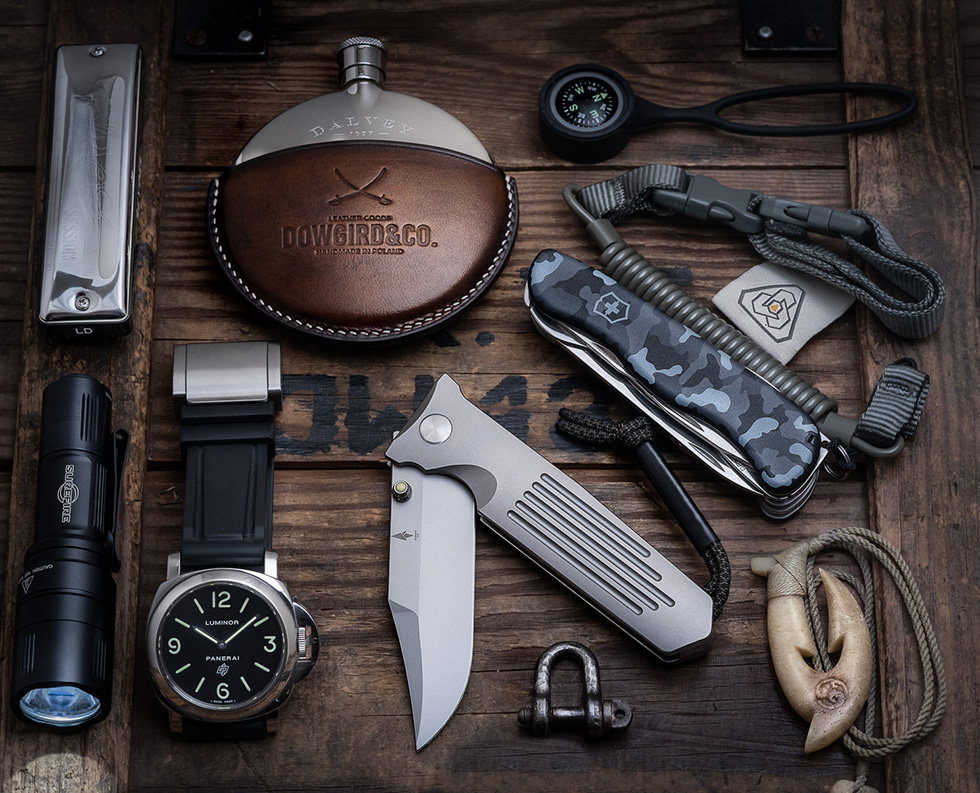
Best for EDC: GiantMouse ACE Riv
MSRP: $220
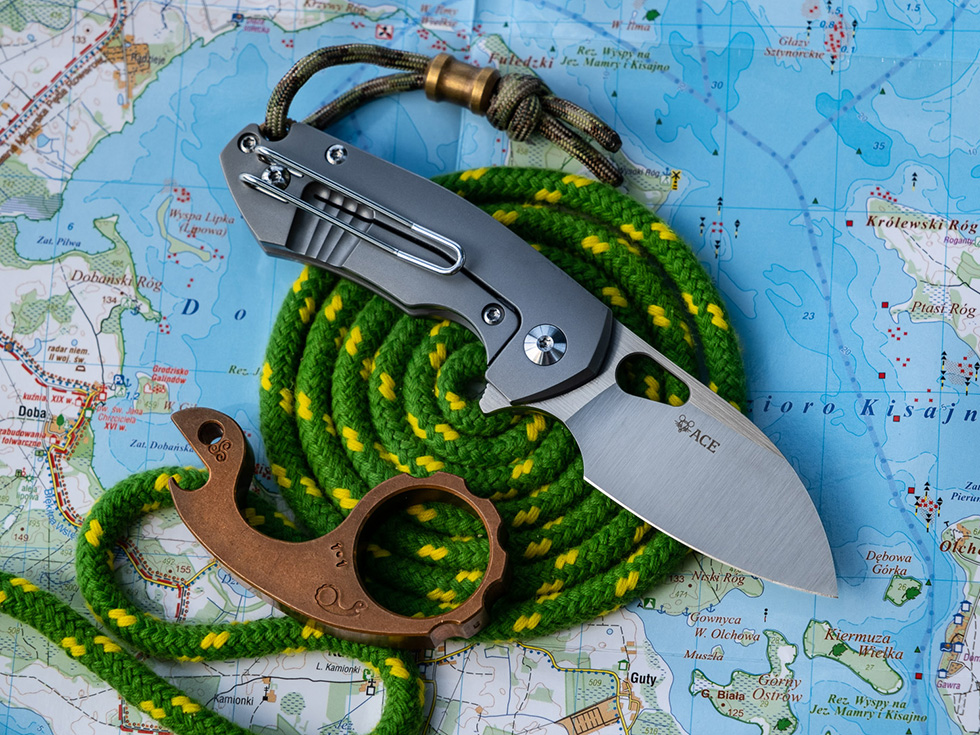
Sometimes what you need is a smaller EDC folder… but don’t want to give up strength, cutting performance, and speed of deployment? The GiantMouse ACE Riv delivers. It features a contoured titanium handle, Elmax steel blade, high grind, flipper opening, and brass backspacer. Designed by two award-winning Danish makers, Jens Ansø and Jesper Voxnaes, it’s a small marvel, almost a jewelry piece.
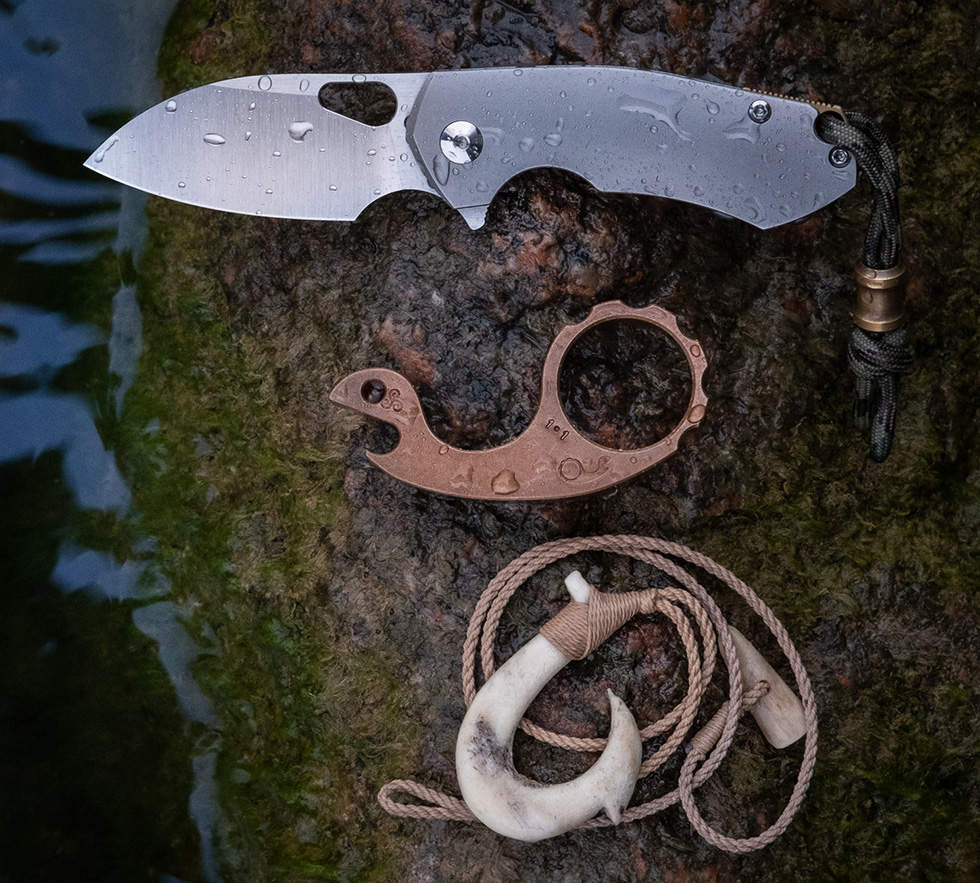
I used it a lot for all small jobs on deck, but also as a true EDC when going out to town or the marina. It’s so small and lightweight that it’ll fit any pocket or purse. But don’t let the size fool you – you can really choke up on it and put some real power behind that cutting edge. In need of a small folder, with a blade below 3″ (which should also be legal in most places)? The ACE Riv could be your classy answer.
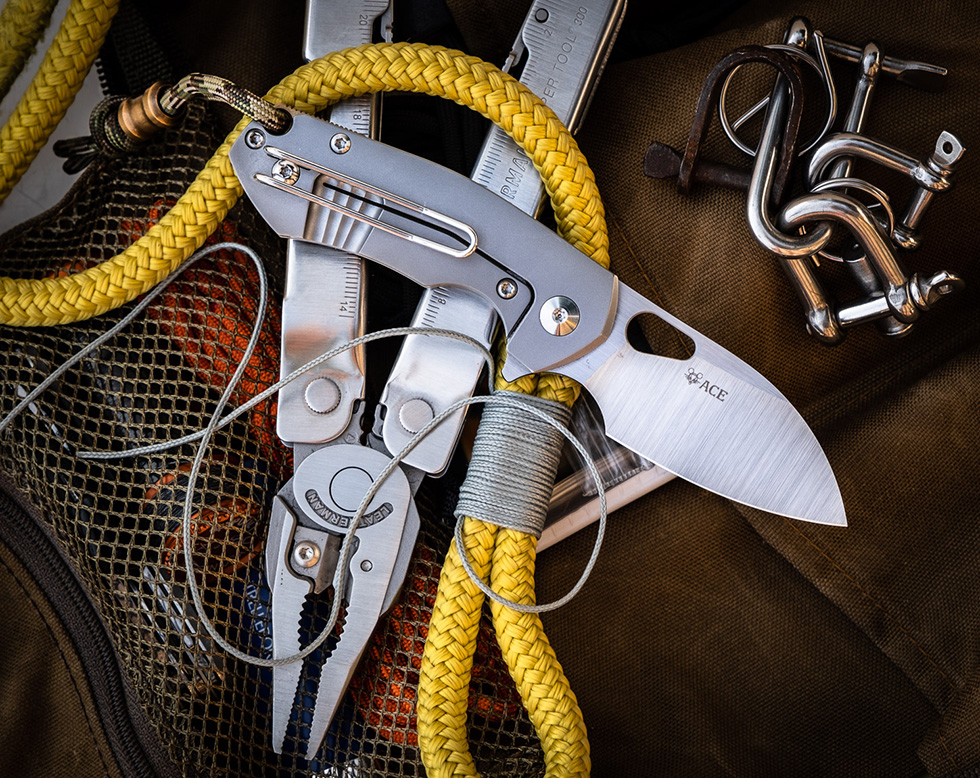
Best Camp Knife: TRC Apocalypse
MSRP: 445 EUR
I know what you’re saying – who’d need such a monster blade on a canoe, right? Well, it really depends. If you’re going to set up an improvised camp on a riverbank evening after evening, or simply prepare a bonfire for you and your friends, then a heavy-duty camp knife could be actually better than an ax! Cleaning bush, chopping branches, splitting / batoning smaller pieces of firewood, preparing simple camp stuff like tent stakes or a cooking tripod – all that is way easier with a big camp knife and a folding saw than with an ax.
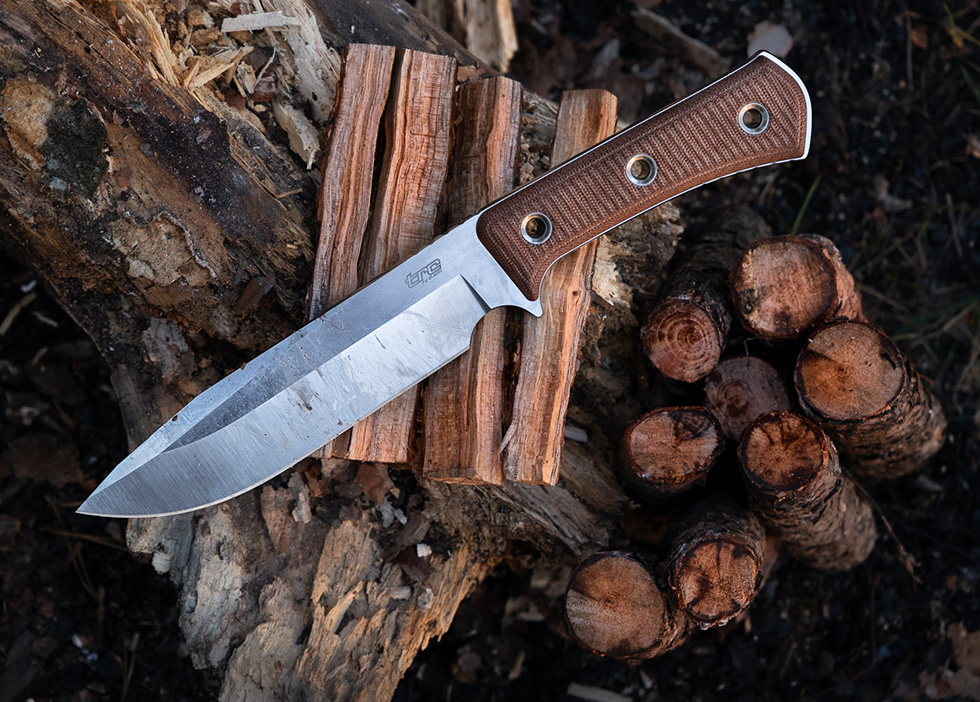
The TRC Apocalypse is a beautiful camp and survival knife. TRC Knives, located in Lithuania (EU), makes most production operations still by hand. That, combined with the sheer dedication of the TRC team, results in perfectly made knives. And my Apocalypse is a good example of that. The Elmax steel is tough, keeps an excellent edge, and has a very high level of stainless properties. A high saber grind provides good cutting properties and stunning chopping performance. The unique tip design makes it both sharp and tough as nails. The Micarta handle is shaped with not just cutting in mind, but also some heavy chopping. And finally the Kydex sheath – I’ve been making Kydex sheaths for myself and friends for a decade now. Still, Apocalypse’s sheath is so well made that I won’t even bother to make my own.
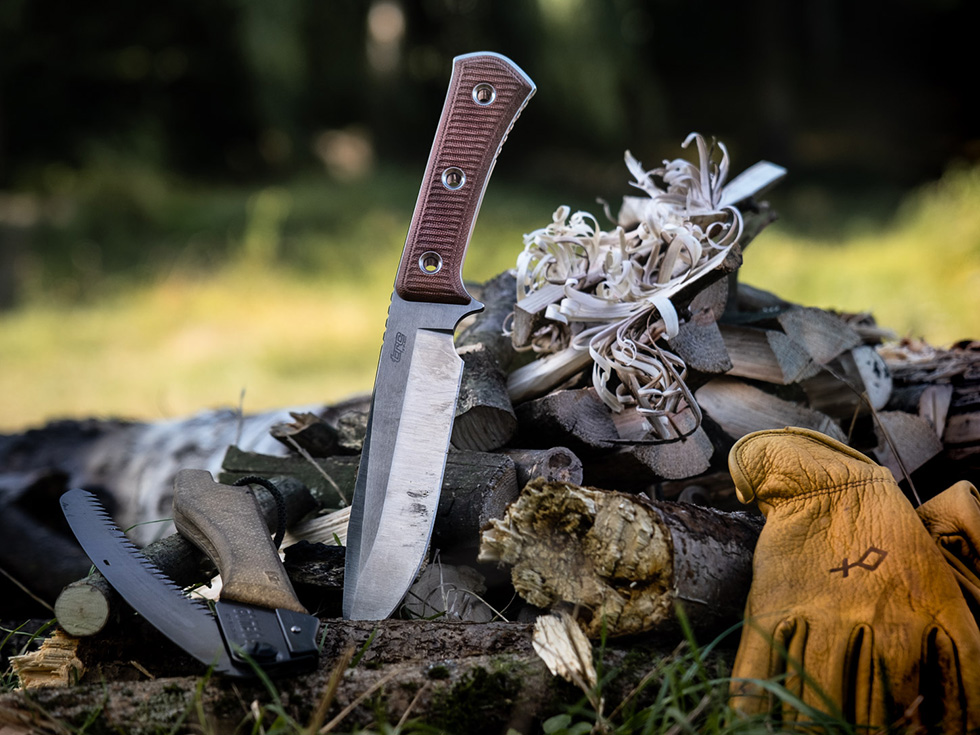
Overall this knife is tough, heavy-duty, but also beautiful and made with a lot of taste. And last but not least – yeah, the spine is 90-degree sharpened too so you can use it with a ferrocerium rod to start a fire. It’s a camp knife on steroids, well suited for overlanding, camping, canoeing, etc. I’ve been using mine usually as a general-use camp knife and for fire preparation and starting.
Best Sailor’s Multitool: Victorinox Skipper
MSRP: $86.99
I could discuss mutitools for hours… but there’s one that is worth its weight in gold on a boat. It’s a Victorinox Skipper (not a “Pro” version), which has been my faithful sailing companion for many years. Last season I retired my old Skipper and got the newest version, which comes with an oversized (and locking) flat screwdriver- a major upgrade for me. Other than this it’s the same good old Skipper, just in a new Navy Camo suit.
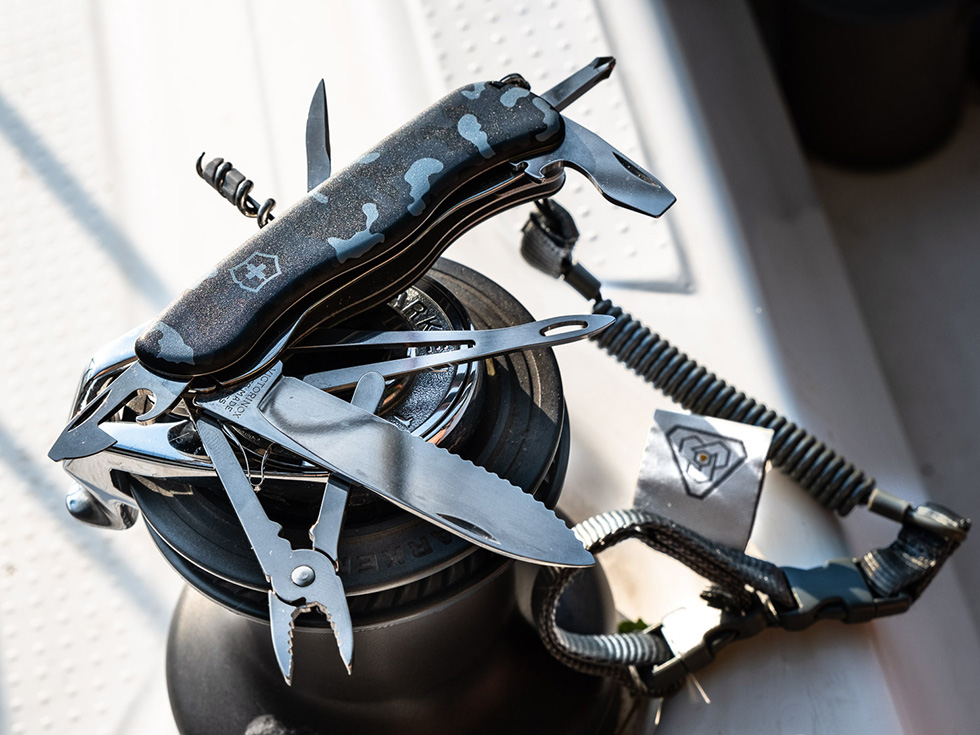
Anyway, the set of tools in it is tailormade for “on deck” jobs. A half-serrated locking blade for cutting rope, Marlin Spike with integrated shackle key and awl for untying knots, rope ends finishing, occasional prying and unscrewing those stubborn rusty shackles. Small pliers for precise work with steel cables and safety pins – you’ll find plenty of both on a sailing yacht. A small hint for anglers: it works great for unhooking fish too. There’s also a secret tool in the Skipper, hidden under the pliers – an in-line Philips screwdriver. Due to the tapering design, it works fine with a variety of Philips head sizes, and being in-line it’s a joy to use.
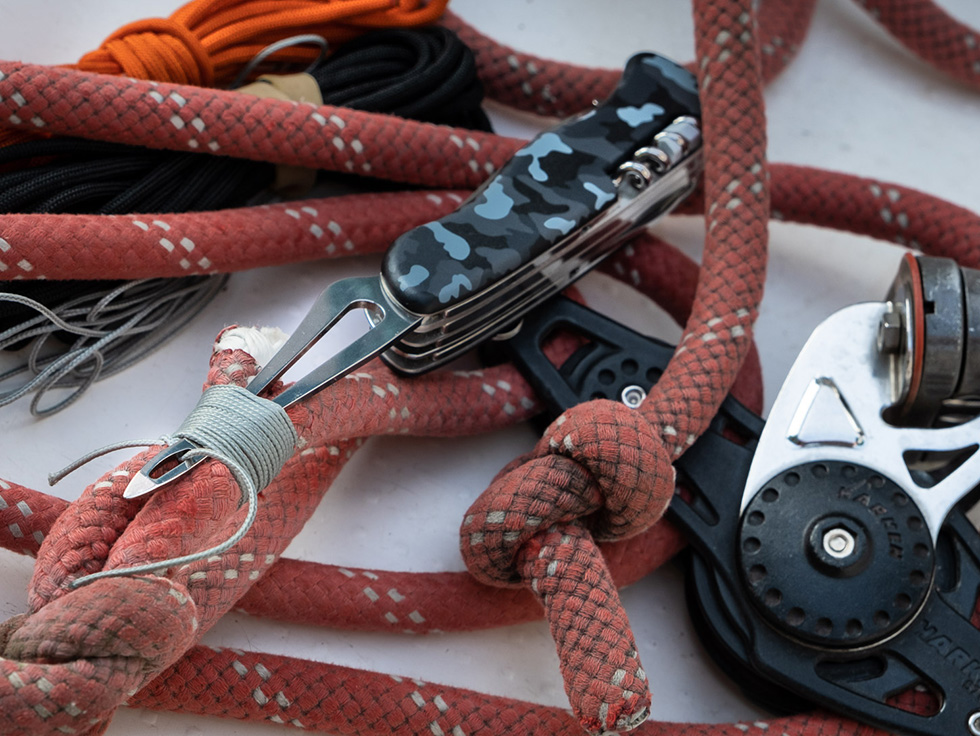
Some more tools are: a big flat screwdriver (locking), cap lifter, and a can opener with small screwdriver. And don’t tell me you don’t use can openers anymore! Have you ever seen a food and water supply on a rescue raft older than a decade (which means a lot of rafts actually used today)? Better have that can opener handy! And finally a corkscrew (with a mini-screwdriver in it), an awl, tweezers, and toothpick. Believe it or not, in the summer it’s my most used Victorinox. Not most carried, but most used for sure.
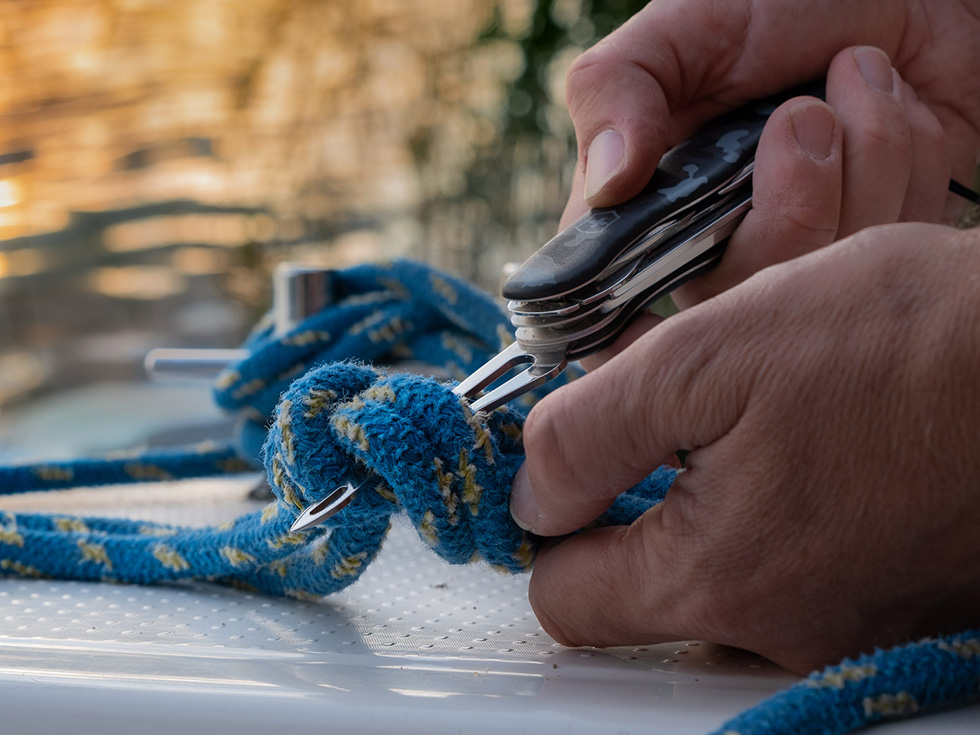
Best Sailor’s Watch: Garmin Instinct Solar
MSRP: $449.99
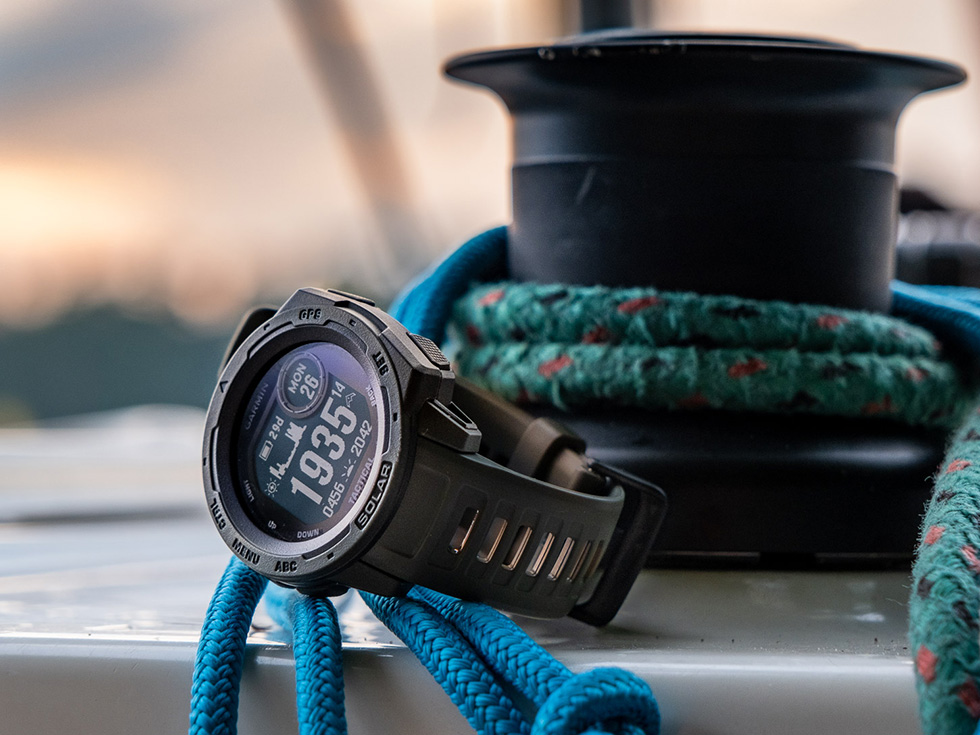
Navigare necesse est, vivere non est necesse. Well, we can discuss if Gnaeus Pompeius was right or wrong, but if you’re behind a boat’s wheel you better have some navigation instruments ready. I say ‘instruments’ because as Marines say: two is one and one is none. A high-end smartwatch with GPS capabilities and a colorful screen is hardly an option on a yacht, mostly because of a limited battery capacity, which often dies after 1-2 days. And that’s where the Garmin Instinct Solar shines as (probably) the best choice for a navigation backup watch.
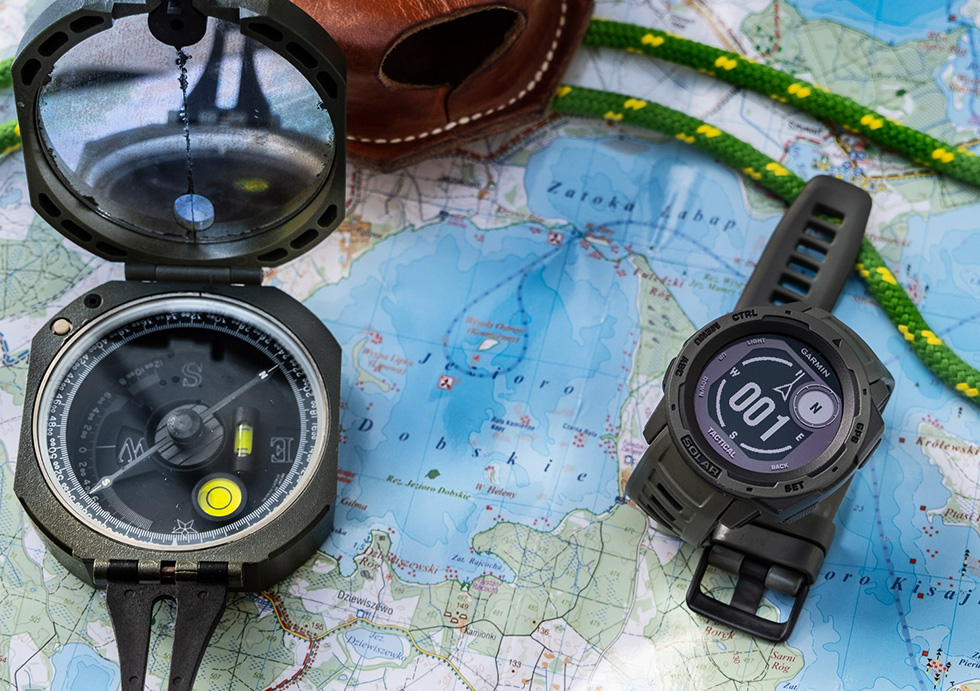
I’ve been using my Garmin mostly for a compass (naturally), weather trends, storm alarm, vibration alarm (not to alert the rest of the crew when waking up for fishing at 5AM), hear rate monitor, and occasionally illumination. I started the trip with 21 days of battery left, ended up with… 29 days left two weeks later! And that’s without cable recharging! The solar charging technology is not a gimmick. The Instinct Solar is also tough, lightweight, and fully submersible too. Yes, the display is just black and white, but that’s why it’s not only energy-effective but also super legible, crisp, and contrasty at any angle. I used to have other GPS / ABC watches, but the Garmin Instinct Solar is a game-changer for me.
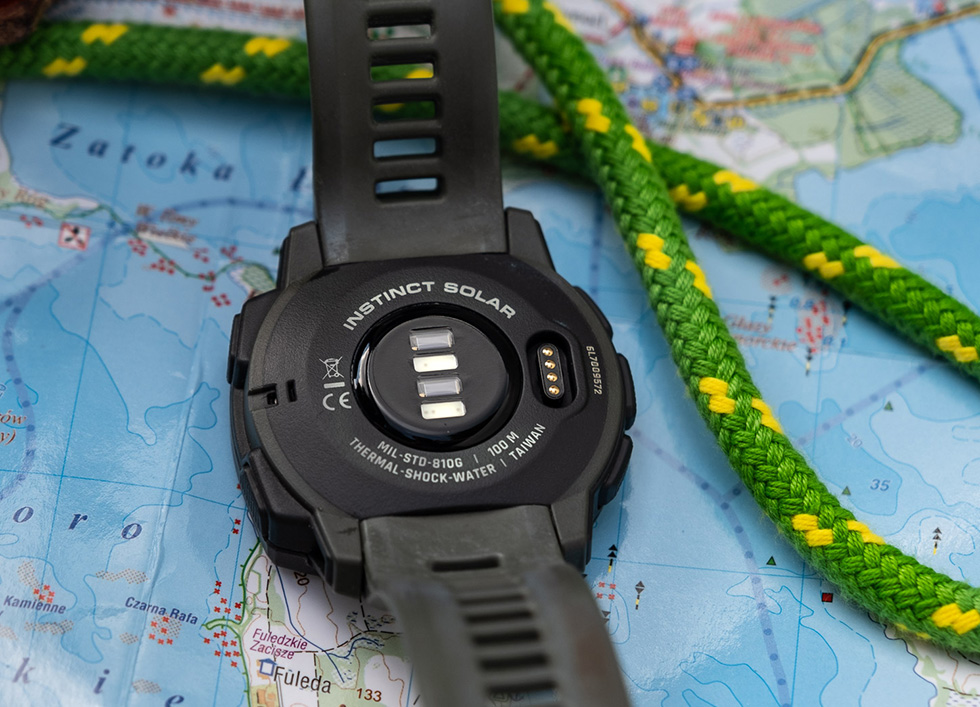
Best for Swimming: Mares ABC (snorkeling kit)
I can’t imagine a real aquatic adventure without snorkeling. This season I tried a classic set by Mares (Avanti AC Pro fins, Pure Vision mask, Pro Flex snorkel). Apart from the entertaining purpose, a good mask and snorkel are mandatory for underwater boat checks and even small repairs of the rudder, keel, or centerboard. So that’s another must-have accessory for me when going yachting. Regarding the snorkel – some people prefer valves, some prefer the simplicity and reliability of an old-school valve-free snorkel. I belong to the latter group. But that’s what I got used to for the last 30+ years of snorkeling.
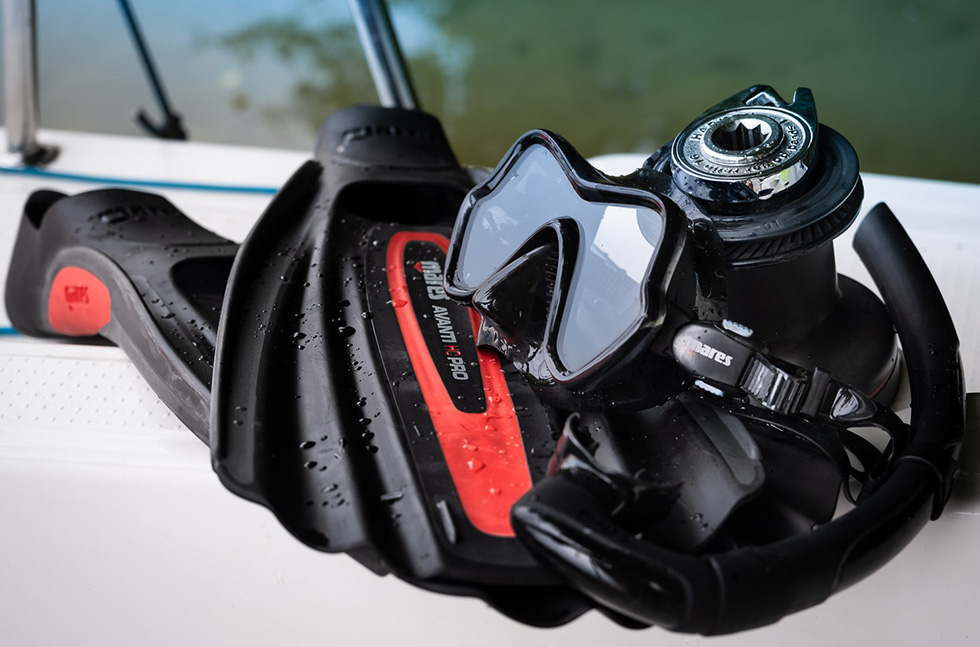
Best Sunglasses: Oakley Anorak, Polarized
MSRP: $203
There’s no way I’d ever go on any outdoor adventure without my shades. Somehow I managed to destroy my Titanium Silhouette glasses earlier this year in the mountains so had to get a decent replacement. So instead of going with Ti again I took a completely different route and got Oakley Anorak sunglasses with Prizm Polarized lenses. The Anorak model is big and bold so looks quite good on a pan-sized face like mine. The Anorak works fine not only for sun protection but protects your eyes from the wind too. And that’s quite important when sailing as you can guess (yes, we sailors like wind!). They stay glued to my face and I was not tired of wearing them even after a whole day.
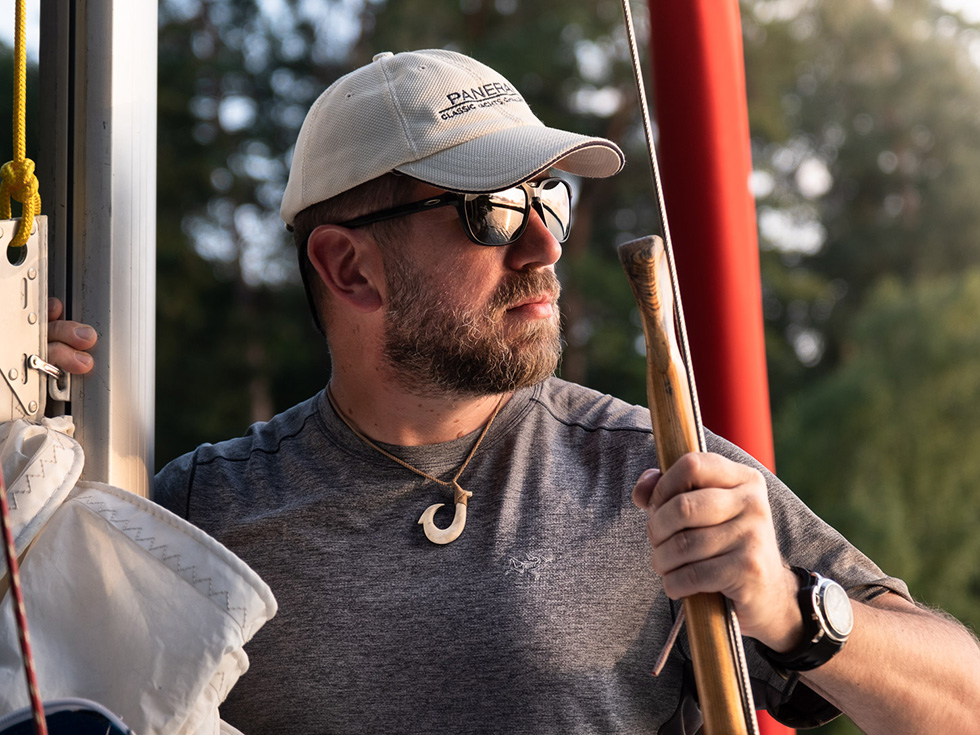
But the Anorak model also has an ace up its sleeve! See that gray bar above the bridge? That’s actually a button – press it, and you can create an extra venting space between the nose piece and the frame. It really works and during a hot day that’s a true blessing! Oakley Prizm lenses are nothing short of awesome too. I decided to go all in and got polarized lenses as they kind of ‘cut through’ the glare on a water surface. So when fishing or even trying to spot shallow water, this is what you want! For any aquatic gear use, polarized lenses are the way to go. More expensive you say? Yes, but try it once and you’ll never go back to standard lenses, take my word for it. The bottom line – these shades are not cheap, but you get what you pay for.
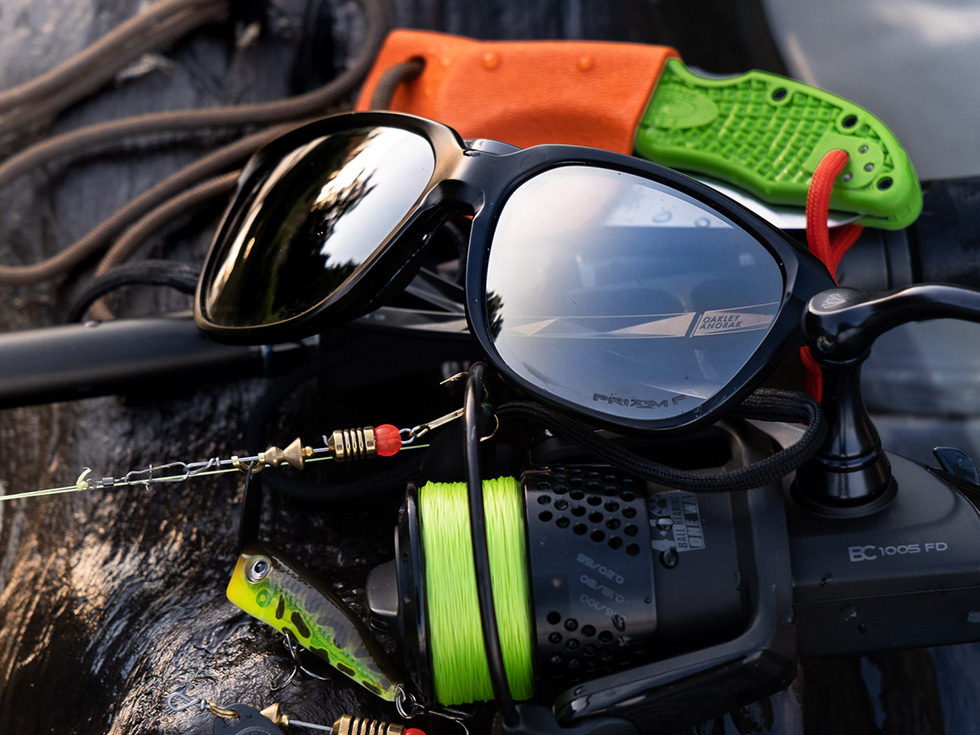
Photo credits: Piotr Ma, Mary Ma





 Carry Awards
Carry Awards Insights
Insights Liking
Liking Projects
Projects Interviews
Interviews
